MILITARY RAILROADS
OF THE NEW YORK METROPOLITAN
AREA:
EARLE NAVAL AMMUNITION DEPOT
NAVAL WEAPONS STATION EARLE
Colts Neck & Leonardo, NJ
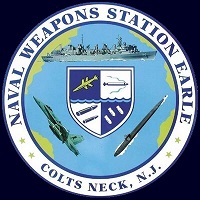
updated:
|
||
update summary |
date | chapter |
| Special Weapons / Limited Area chapter amended | 03/15/2021 | Special Weapons Storage Compound - "Limited Area" |
.
|
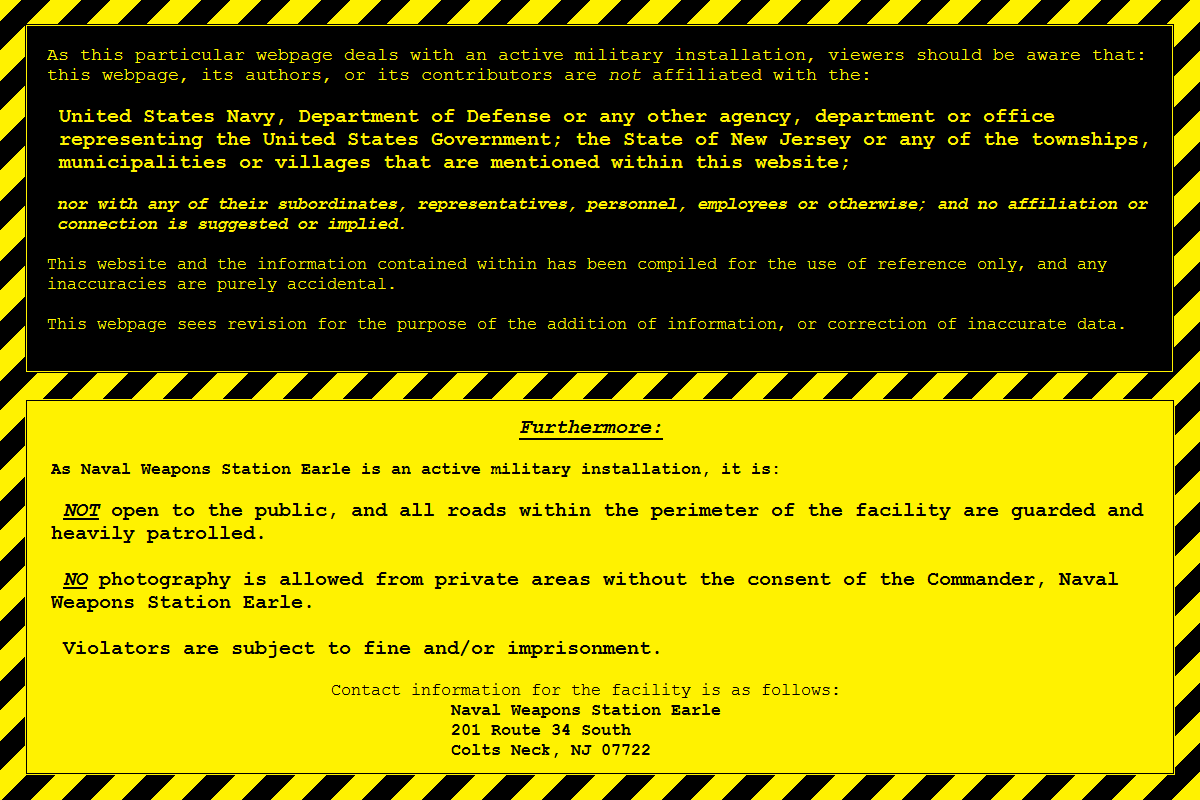 |
| History | The El Estero Accident | Trackage | Special Weapons Storage Compound - "Limited Area" | |
| URHS Excursions | Locomotive Roster | Locomotive Photos | Rolling Stock | Special Thanks |
The establishment of Earle Naval Ammunition Depot predates World War II, but with the entrance of the United States into World War II, a better modern facility was needed to service the Atlantic Fleet. With the remoteness and limited size of Iona Island Naval Ordnance Depot in Hudson Valley of New York (which could not be expanded due to being an island) and Lake Denmark in northern New Jersey with its close proximity to Picatinny Arsenal were conditions stacked against them. A board was established to locate a suitable site, and after surveying several, they eventually chose Sandy Hook Bay. This location featured a sheltered port where ships could take on ammunition, and also had the advantage of several rail lines nearby which directly connected to Class 1 railroads. This made it convenient to receive ammunition manufactured and assembled from the western US, where the majority of shipments originated, as well as convenient for naval vessels to moor and load / unload their munitions. Adding to this was the fact was the area of the New Jersey Highlands was almost undeveloped and rural (at that time) which meant only a minimal amount of local residents would need to be relocated as well as seclusion for security reasons. The proposed location passed approval, and on 02 August 1943, construction began on Naval Ammunition Depot Earle. It is so named after Rear Admiral Ralph Earle, Chief of the U.S. Navy Bureau of Ordnance during World War I. Construction proceeded rapidly as the depot was now quite vital to the U.S. war effort in Europe. Earle Naval Ammunition Depot was commissioned on 13 December 1943, though work continued on the thoroughfares and railway connections between the mainside complex, the waterfront complex and the pier, which stretches 2.9 miles into the Sandy Hook Bay. | 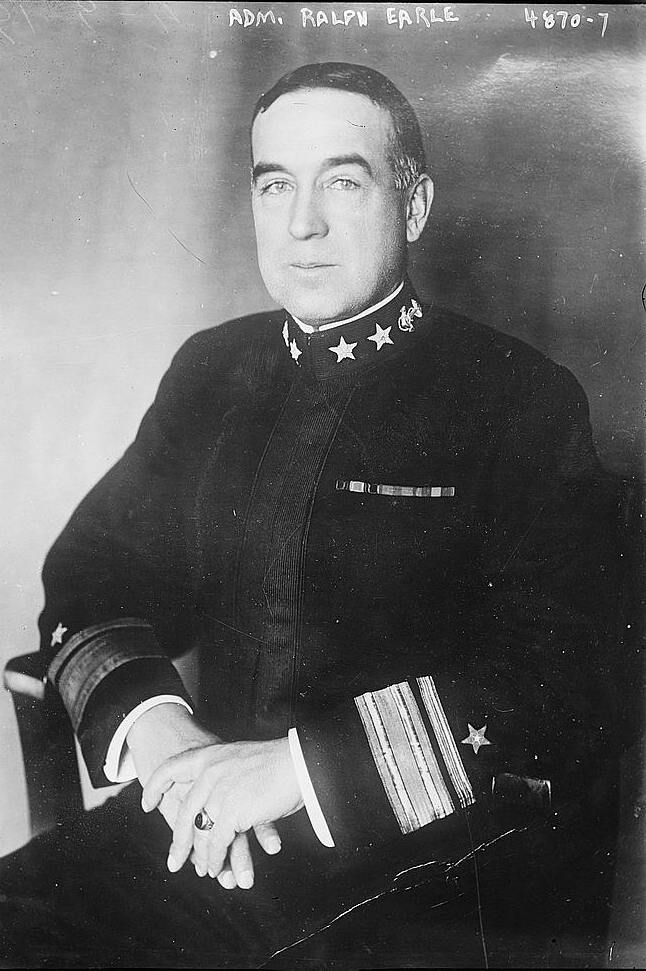 Admiral Ralph Earle, USN 3 May 1874 – 13 February 1939 |
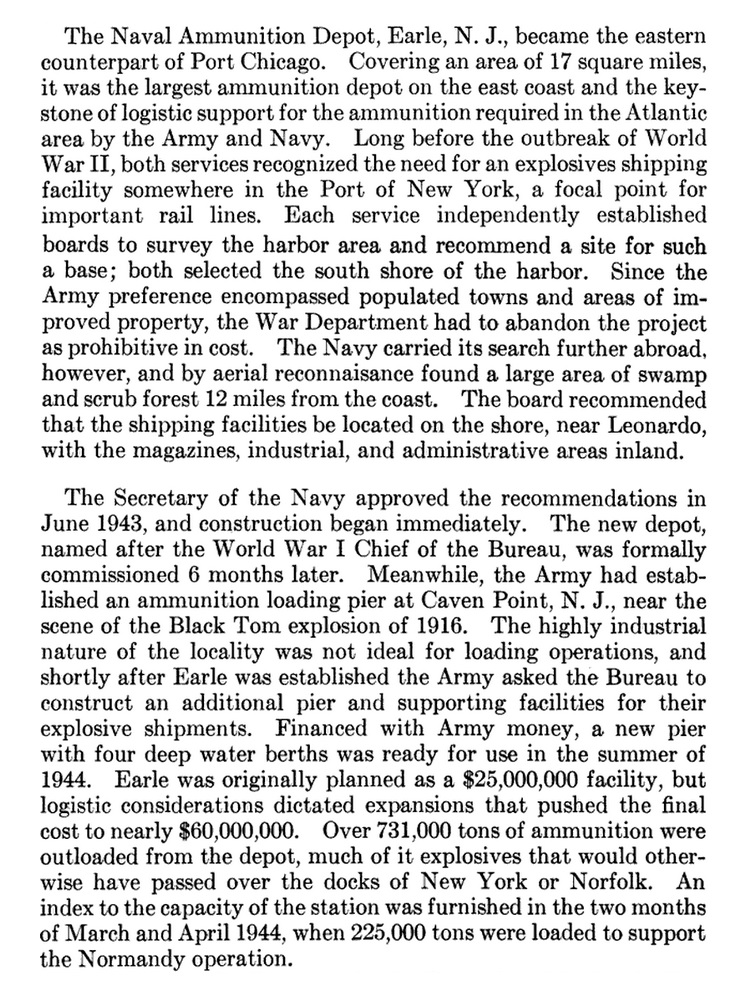
.
.
| Return to Index |
.
.
On 24 April 1943, the SS El Estero had taken on 2,730,000 pounds (1,365 tons) of mixed munitions at the Caven Point (Bayonne), NJ dock and was preparing to sail at 17:30. A boiler flashback started a fire on oily water in her bilges, which quickly grew out of control. The initial response to the fire brought five fire apparatus of the Jersey City Fire Department, including two 30-foot fireboats as well as approximately 60 Coast Guardsmen.
Moored directly opposite the El Estero were two other fully laden ammunition ships and two ammunition-laden consists of railroad boxcars. If a simultaneous detonation were to occur, and with over 5,000 tons of ammunition involved; this would have been equivalent of the yield of a 5 kiloton tactical nuclear weapon (about 1/3 the yield of the Hiroshima - Little Boy fission bomb).
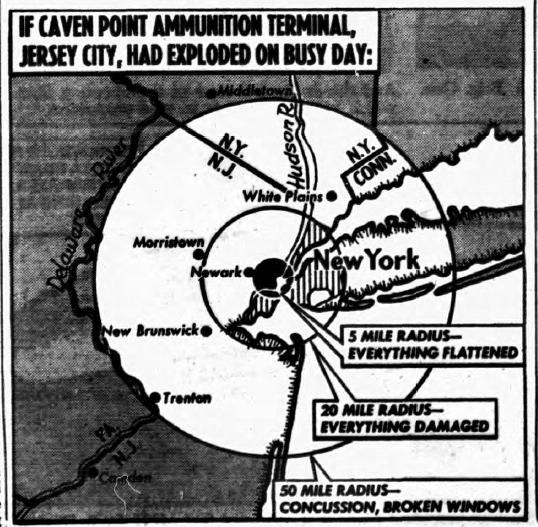
From the August 2nd, 1945 NY Herald - PM Daily edition
sourced via fultonhistory.com
added 06 May 2019
.
.
That newspaper diagram is a little bland in detail, so here is 5 mile diameter circle (in red) superimposed on a Google Map Satellite View photo of Caven Point Pier (albeit with present day development) and the surrounding vicinity. Everything would have been flattened in that circle.
The black circle represents the area of structures flattened in the Black Tom (Lehigh Valley Railroad) Explosion of 1916. (Please note that debris from the explosion had been projected much further and as far as Journal Square.)
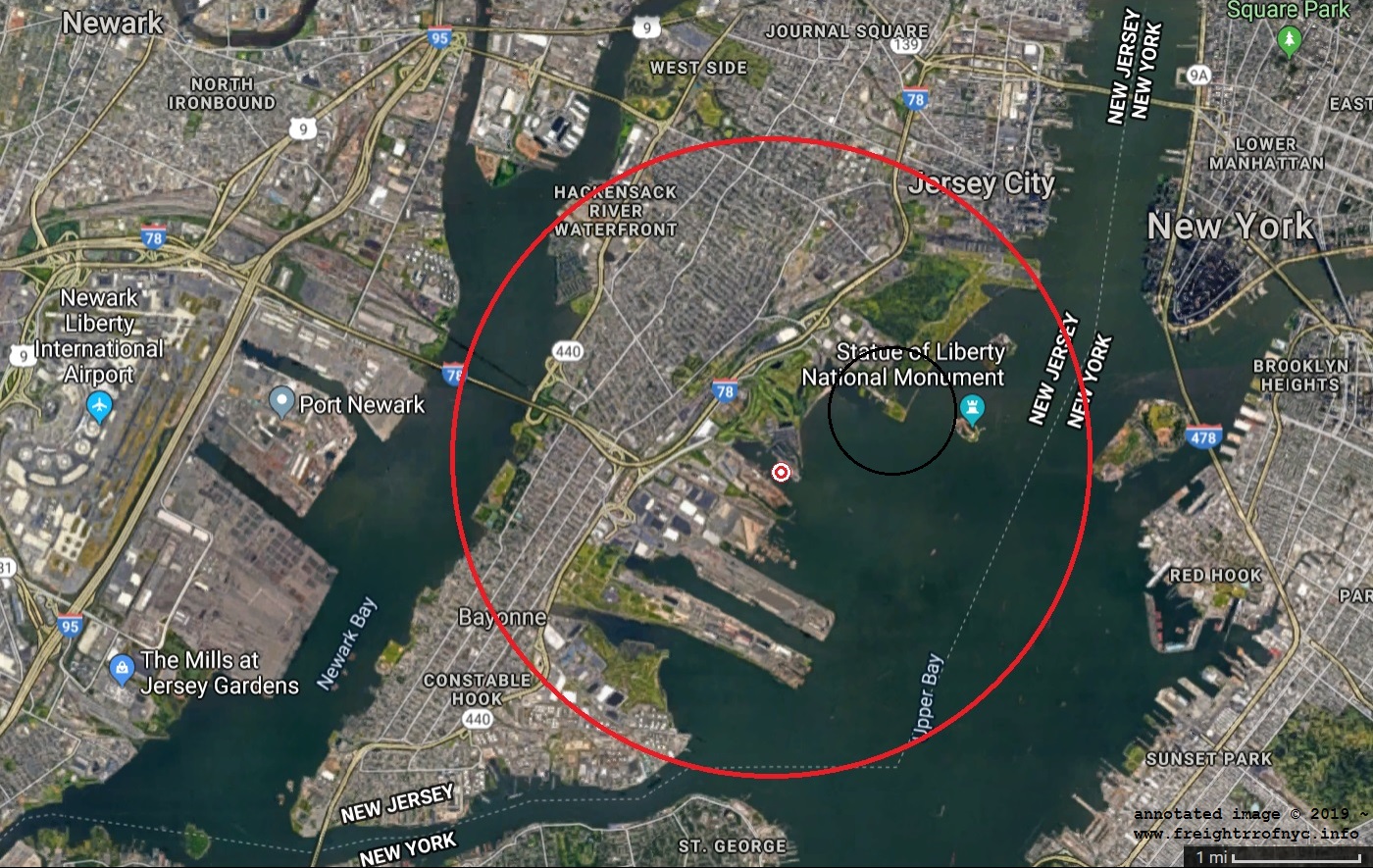
courtesy of Google Maps
.
.
The Black Tom explosion (munitions, TNT) that took place on July 30, 1916 in Jersey City, NJ had an explosive force of about 1 kiloton. To witness an explosion of this magnitude; the fourth, final and largest explosion at the PEPCON Plant located in Henderson, Nevada on May 4, 1988 was also approximately 1 kiloton of explosive force.
Also of similar explosive force was the Beirut Explosion of 2020
in which 2,750 tons of ammonium nitrate detonated with a 1.1 kiloton
yield of explosive force. Videos of both of these explosions can be
viewed on YouTube.
However, it should be noted the desert surroundings of the PEPCON Plant
make a poor comparison to the center
of a industrial area like Black Tom or Caven Point, however the Beirut
explosion taking place in the center of a port surrounded by commercial
and residential structures is much more accurate to the effects of the
Black Tom explosion.
The Halifax Harbor, Nova Scotia
explosion (explosives and munitions) of December 1917 was almost three
times the force of Black Tom and PEPCON. That explosion was
approximately 2.9 kilotons in explosive force and devastated Halifax. The Texas City
/ SS
Grandcamp explosion of 1947 (and had not yet taken place), was slightly
larger at approximately 3.2 kilotons. The Grandcamp explosion
(ammonium nitrate) would become the worst industrial accident and
largest non-nuclear explosion in US history. All of these pale in
comparison to the potential explosion of the El Estero at 5 kilotons.
Without exaggeration, a blast of this magnitude would have destroyed the surrounding docks and freight yards and terminal facilities the Pennsylvania RR at Greenville along with other railroad yards & terminals in the vicinity, Bayonne, the Statue of Liberty, numerous oil refineries and other critical industries in the area.
Outside of the 5 mile zone, the blast would have severely damaged most of Jersey City and Newark, NJ; St. George Staten Island; Governors Island; the Sunset Park and Red Hook neighborhoods in Brooklyn, as well as Lower Manhattan.
So, with the Black Tom and Halifax explosions still in the collective memories of many; firefighting efforts began in earnest. It was quickly discovered that the severity of the blaze prevented access to the El Esteros' seacocks, making any attempt at flooding the ship not feasible.
A call went out to the New York City Fire Department, which in turn dispatched its two most powerful fireboats; the "Fire Fighter" and the "John J. Harvey", to the scene (both of which are retired but still around as floating museums!)
This assistance arrived at 18:30 and immediately began running hoses up to Coast
Guardsmen on the burning ship, with the fireboats taking positions directly
alongside El Estero, while three commercial tugboats made up a towline to the bow of the El Estero and began pulling her
towards the open water of Lower New York Bay, via The Narrows located
between Brooklyn and
Staten Island. For the record, one of these tugboats was none other than the Beatrice Bush, of the Bush Terminal Railroad! What a coincidence and what a great tie in between this page and Bush Terminal!
Despite an imminent explosion, the Coast Guardsmen, firefighters and tug crews continued their efforts to contain and extinguish the blaze (and to save as much of the ship and cargo as possible - both of which vitally necessary to the war effort), but the Port Admiral of New York Harbor ordered the ship sunk. So the tugs shifted to a shallow area of Upper New York Harbor off Robbins Reef Light, where the fireboats began a deluge of 38,000 gallons of water per minute (the fireboats combined maximum capacity) into the El Esteros' cargo hold. This succeeded in swamping the ship shortly after 21:00. With all hotspots declared extinguished by 23:30, the all-clear for residents and businesses surrounding New York Harbor was transmitted over the radio.
This incident was considered to be the single greatest threat to New York City during World War II (but of which passed without major incident or loss of life), and an impetus to move the munitions handling out of Upper New York Harbor and away from the population centers.
The importance, convenience as well as the safety of the location for the Earle Naval Ammunition Depot allowed it to develop after World War II, keeping pace with the changing missions of the U.S. Military, and the growing explosive power of the weapons it uses.In 1974, the depot's name would be changed to Naval Weapons Station Earle.
Sam Berliner, III (now deceased) spent a great deal of time and effort in assembling the corresponding quadrangle maps that cover the entirety of Naval Weapons Station Earle; and these are dated 2014. I further edited them to better highlight the NWS Earle property boundaries.
Clicking on the image below will bring you to a a large size version.
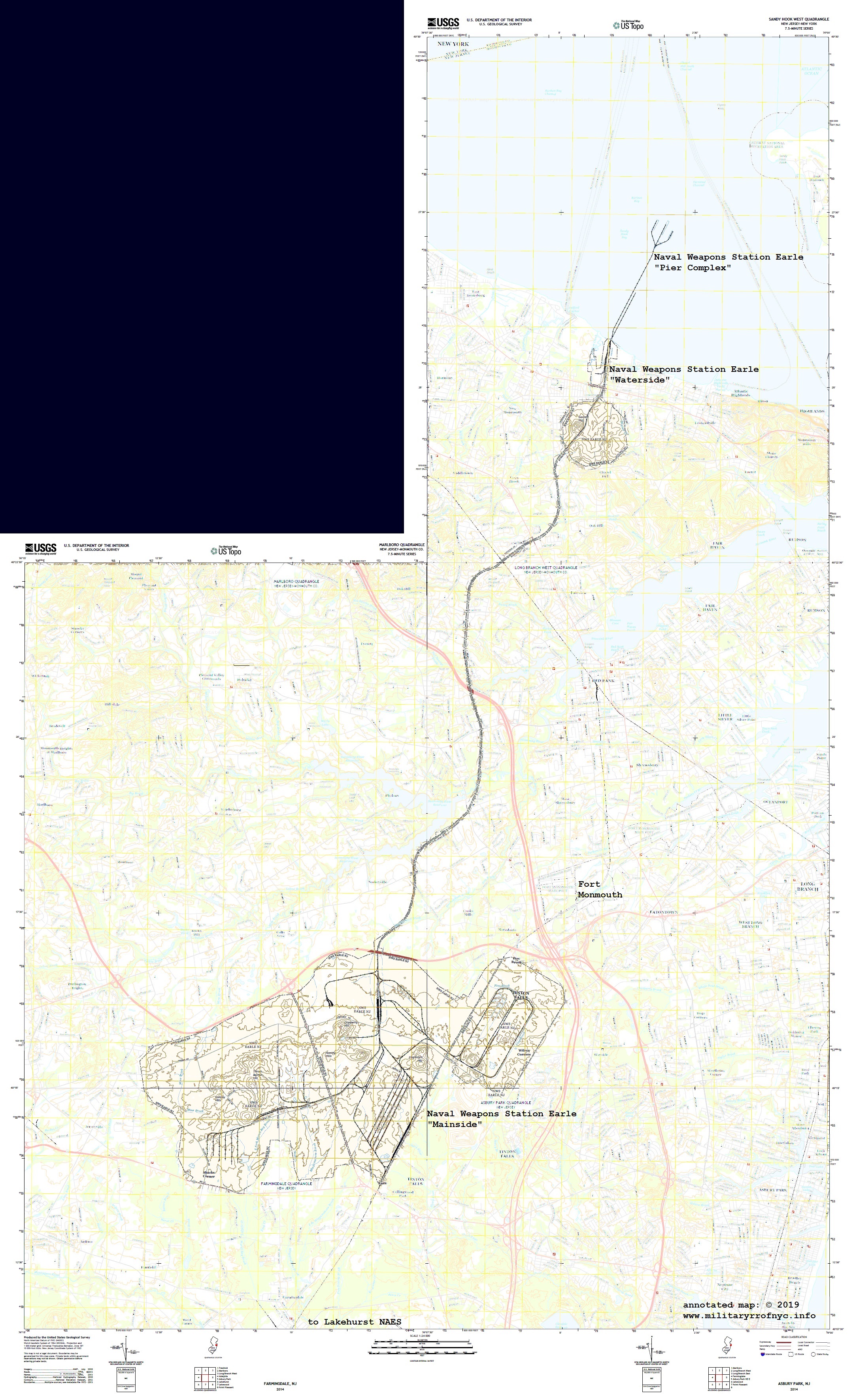
United States Geological Survey - 2014
original compilation courtesy of Sam Berliner, III website
Naval Weapons Station Earle and R.O.W. highlighted by author annotated image: © 2019 by author
added 06 May 2019
.
.
| Return to Index |
.
As for the Leonardo Piers themselves, and their being of historical importance, a Historic American Engineering Record - (HAER NJ-142-B) was completed by the U.S. Department of the Interior in 2003. Here we will defer to actual maps drawn for the construction in 1944-1945.
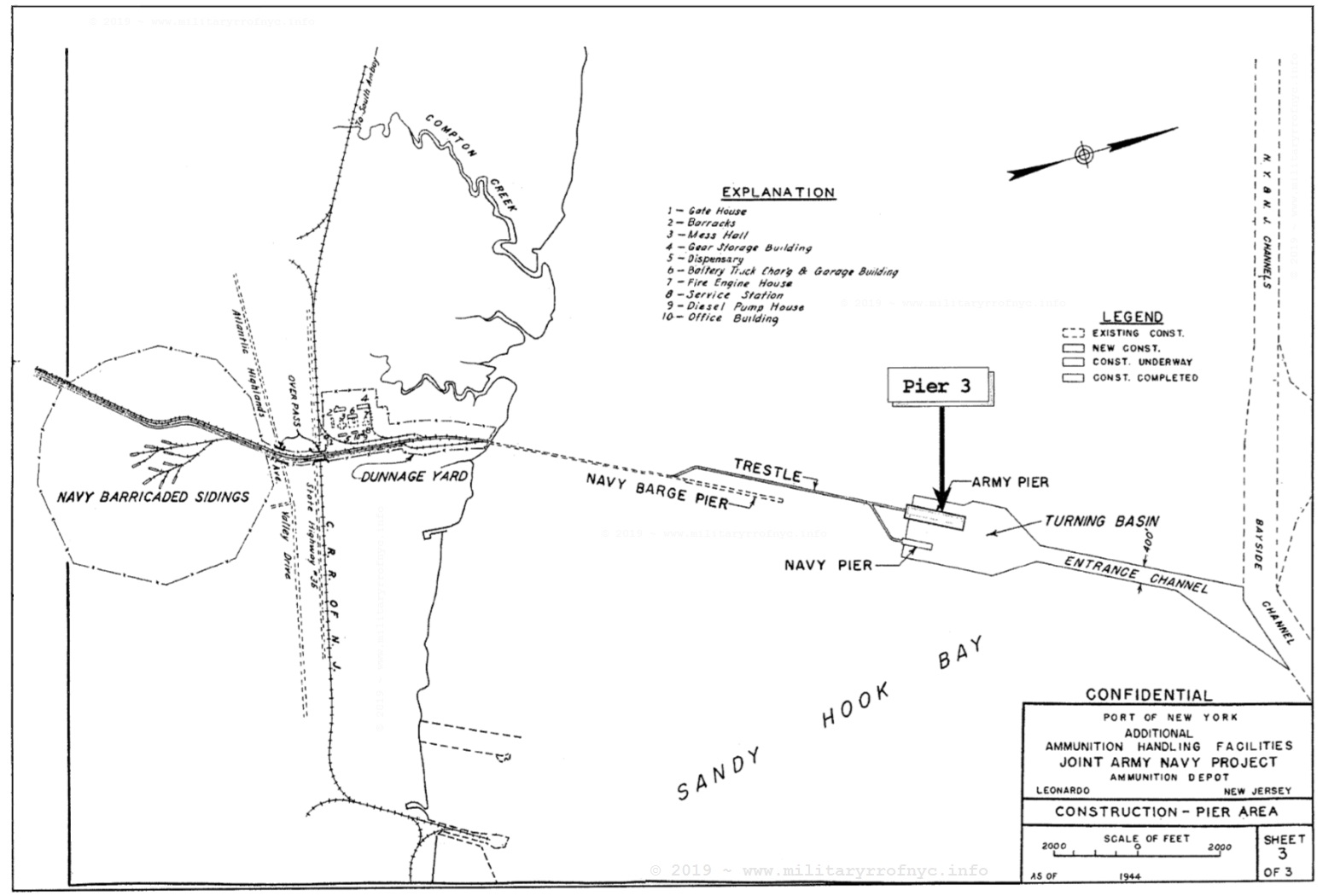
Addition of US Army Pier - Leonardo, NJ - 1944
Earle Naval Weapons Station - Historic American Engineering Record - HAER NJ-142-B
U.S. Department of the Interior, 2003
(cleaned by author)
added 06 May 2019
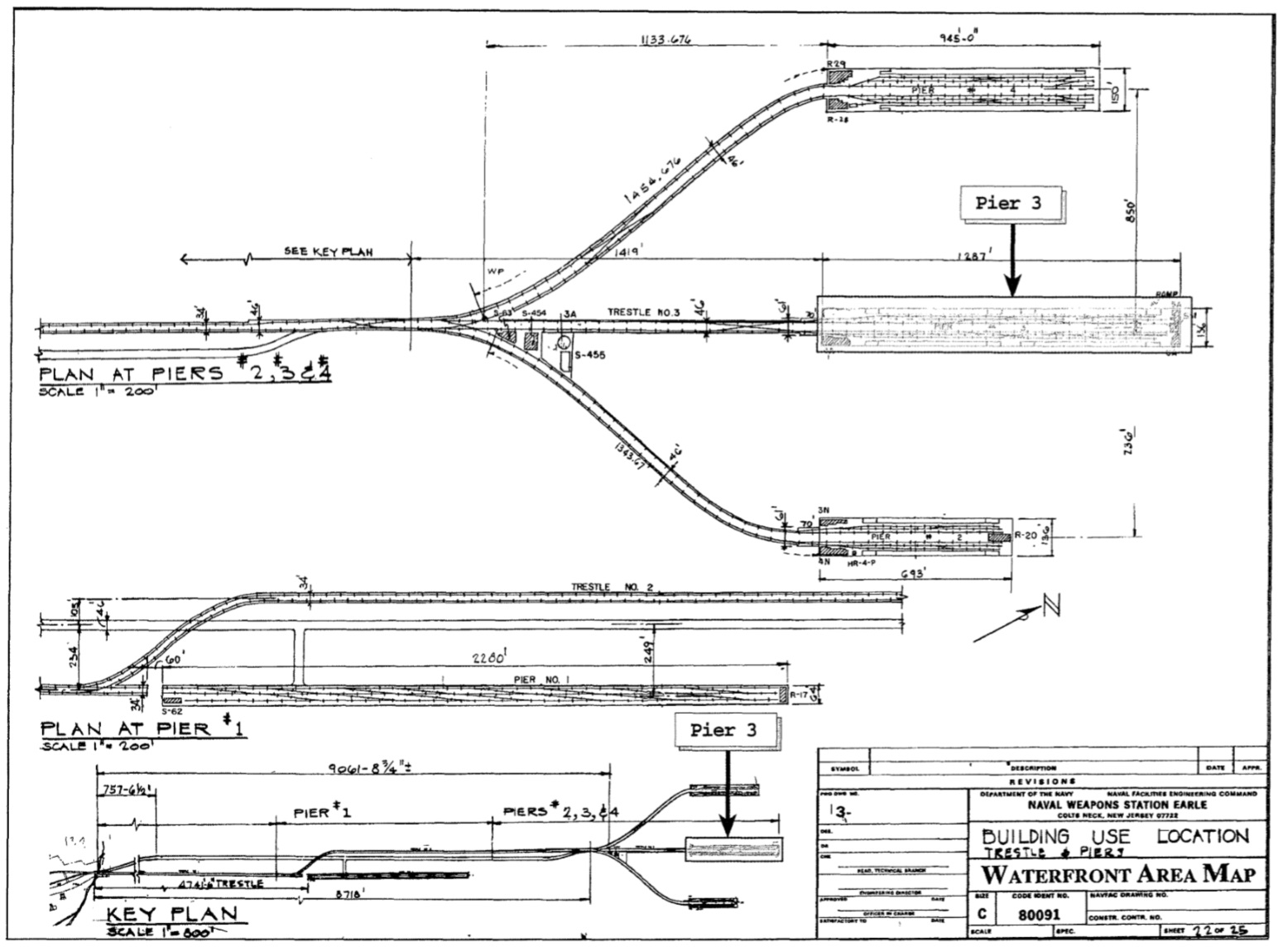

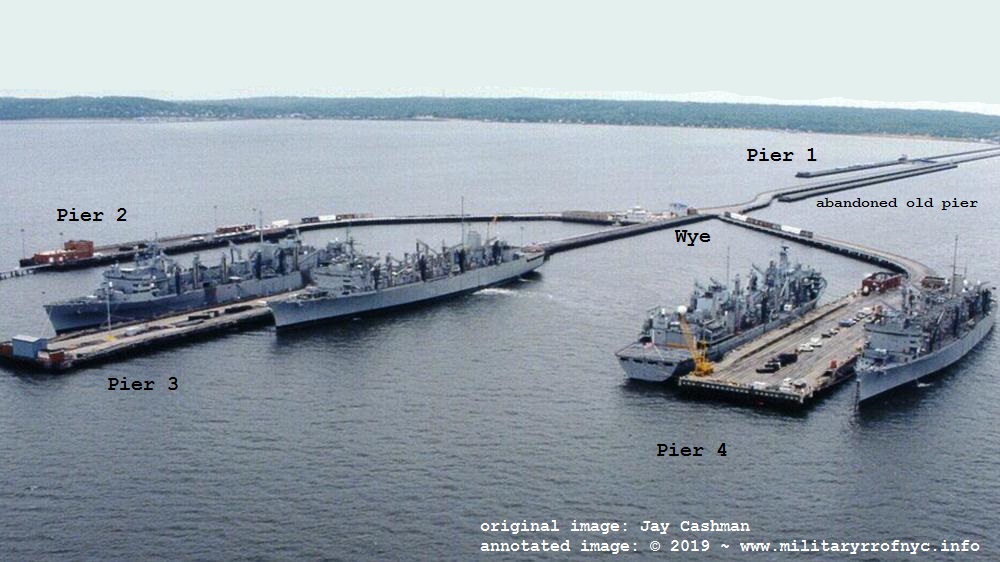
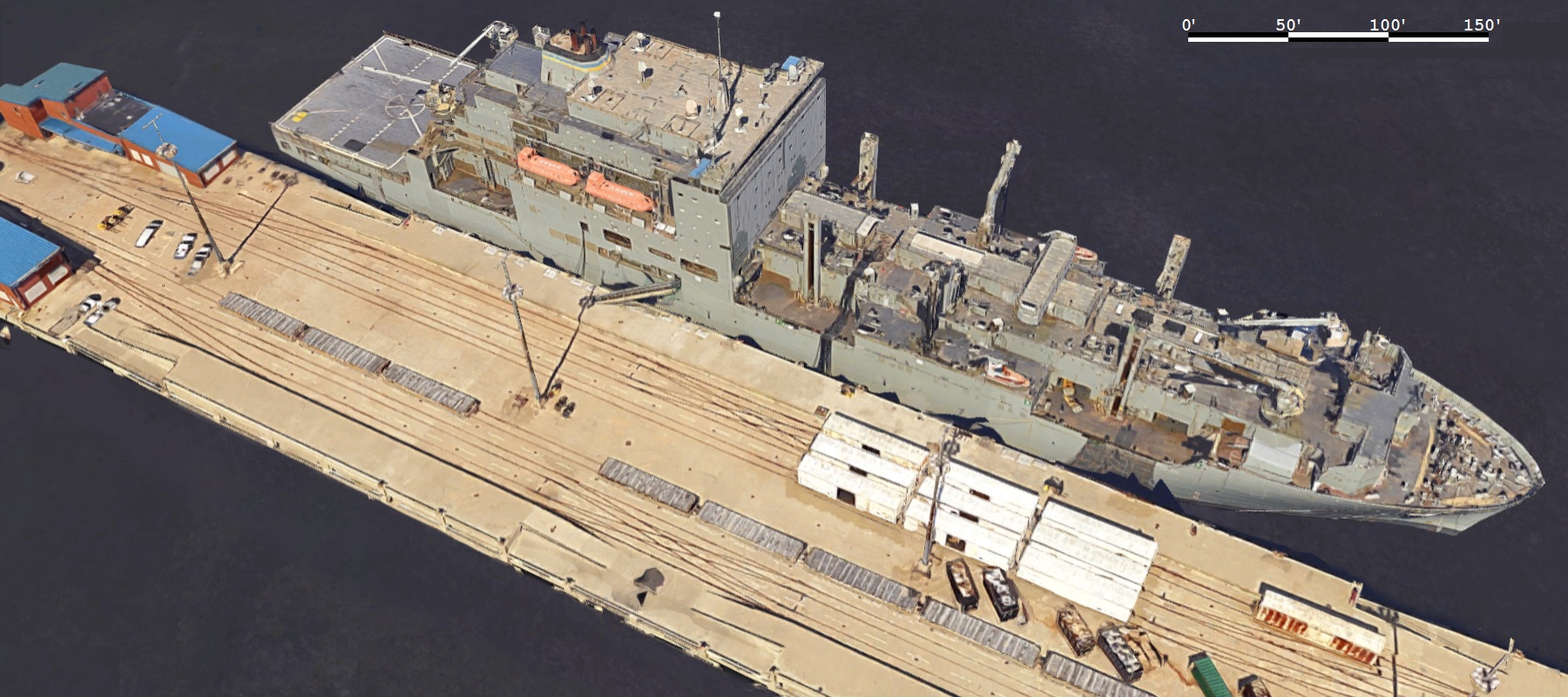

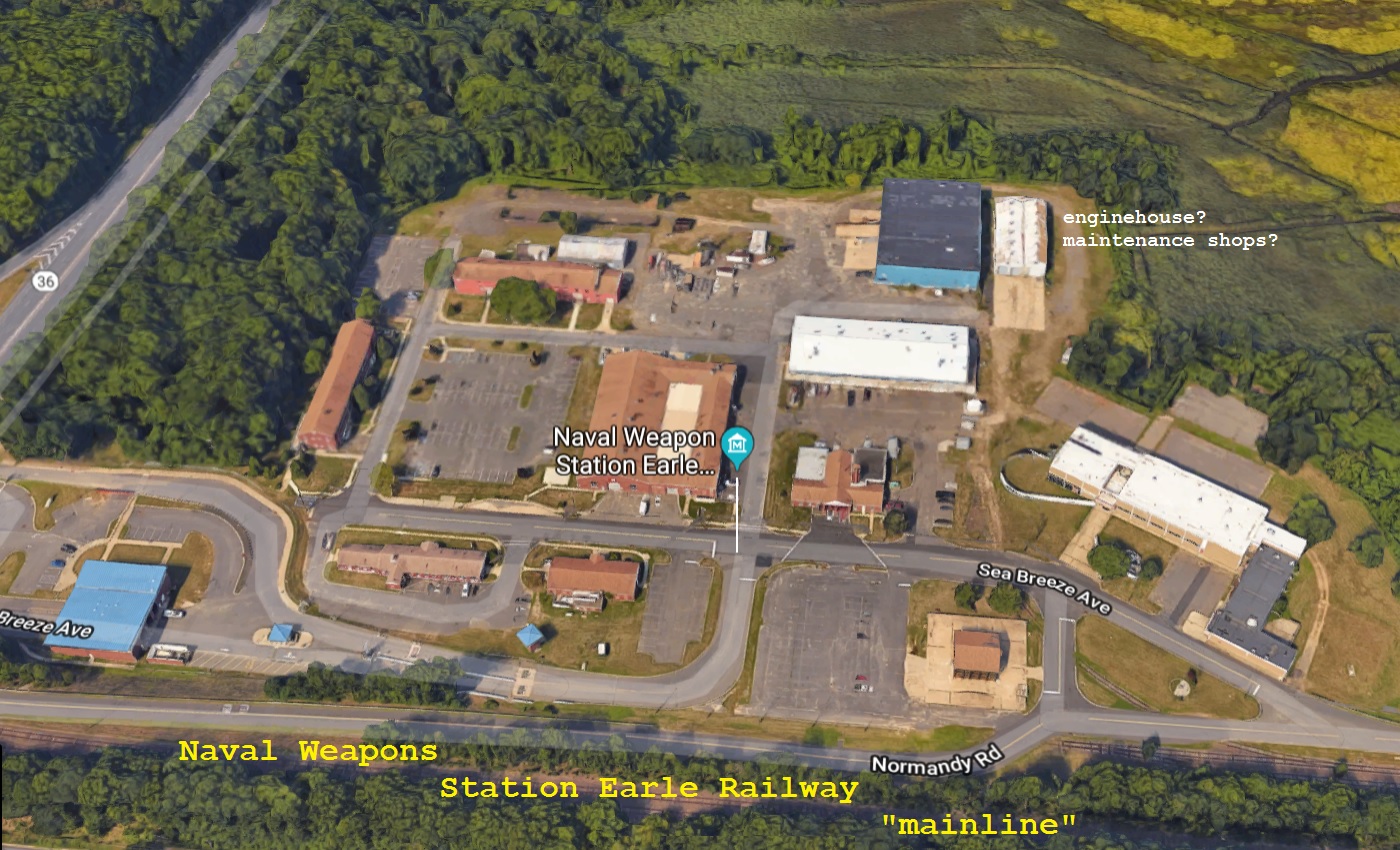
The trackage at Naval Weapons Station Earle has many loops, wyes, sidings, encircling different sections of the facility and spurs and stubs leading to various bunkers within the complex and spread out among the property. The total amount of "bunkers" is approximately 250, but not all are serviced by the railway and not all those served by the railway appear to be used.
The actual name for a bunkers is "magazine" and the Department of Defense denotes two types: Earth Covered Magazines, and Above Ground Magazines. The construction differences are specifically explained in detail in the open source document:
| Unified Facilities Criteria - Ammunition & Explosives Storage Magazines; DOD 2015 |
The following map is a fairly decent representation of the layout, using aerial mapping, but as to which tracks that are currently active, inactive, out of service or that have been removed cannot be confirmed do to the off limits nature and the size of the facility.
It is assumed each area has a specific purpose: small arms, artillery shells, missiles, obsolete weapons awaiting disposal, etc, and of course the special weapons area. One thing is almost certain: the wider the spacing between stubs, the more explosive power the weapon being stored has.

Naval Weapons Station Earle - Mainside - Colts Neck, NJ (north is up)
Google Maps
annotated image: © 2019 by author
added 06 May 2019
.
.
Neither the US Navy, Department of Defense, Department of Energy, National Nuclear Security Administration (NNSA), nor any other US Government Agency has ever confirmed or denied the storage of nuclear weapons at Earle Naval Weapons Station. Nuclear weapons are more commonly called "special weapons" or "devices" in defense circles of discussion.
There are a few misnomers and assumptions that need to be clarified in discussing nuclear weapons.
While one commonly thinks and visualizes a nuclear weapon being a large sea launched ballistic missile "SLBM" from a ballistic missile submarine: ("SSBN" or "boomer") of which these would have been administered to in the dedicated fleet ballistic missile submarine bases at Kings Bay, GA; or Kitsap - combined Bremerton and Bangor, WA as well as Norfolk, VA; or an ICBM from a Air Force missile base in the Midwest, or a large bomb dropped from an Air Force bomber like a B-52. These weapons fall into the category of strategic nuclear weapons.
But in fact, there were many other nuclear weapons intended for use as necessary in a tactical warfare environment; and are so named tactical nuclear weapons. However, it should be noted some weapons can be dual purpose: strategic as well as tactical. It should also be recognized that explosive yield does not determine strategic or tactical usage; the fighting environment & range does. Have a submarine threatening your battle group from a few miles away? Tactical. A small shipborne or aircraft launched missile detonated over a city becomes strategic and an ICBM or SLBM with a single warhead that used to destroy a ship or several ships is now tactical in nature. Enemy forces on the ground about to occupy a city in friendly territory? Tactical. Destroy an enemy city in their country for either retaliation to the loss of a city of yours or to eliminate military production? Strategic.
In most cases, tactical nuclear weapons are usually simple gravity dropped bombs or small missiles that can be mounted under the wings of aircraft, put in a torpedoes or depth charges.
It is also pertinent to realize how compact modern nuclear weapons are. While the intercontinental ballistic missiles themselves, as large as they are; they are only the delivery vehicle. The nuclear devices themselves are contained within reentry vehicles, and dimensions are generally accepted as cone shaped, around 6 feet tall and 38 inches in diameter at the base. Several of these fit under the nose cone of either the Minuteman III ICBM or Trident II SLBM (the actual number can vary based on the arms limiting agreement in effect).
The actual nuclear device, the fission "primary"; is actually quite small - about the size of a soccer ball or even smaller. The "secondary" or the fusion part of the two stage or "thermonuclear" weapons also fit inside the cone shaped reentry vehicle along with the necessary electronics and devices for safety, accurate deployment, detonation at the correct parameters.
Think of them as a Matryoshka doll - the Slavic dolls that get progressively smaller to fit inside of one another. The smallest doll is the one that that is the key. To make a long story short, the actual nuclear device or bomb portion is quite small, and rather portable.
It is this portability that concerns defense agencies and results in the security measures that surround nuclear weapons storage. Which is why agencies will not confirm or deny their presence at a specific location.
Never the less, despite this lack of confirmation or denial, and considering the mission of the U.S. Navy during the Cold War through Desert Storm; it is entirely feasible and with almost certainty, that nuclear weapons were stored in the Earle Depot. (You got an L or Q clearance? Then you will know for yourself.)
On the issue of safety, nuclear weapons, after the two initial designs of 1945; are actually safe when inferring to an accidental detonation. While the weapons components can rupture or catch fire in an accident (such as an airplane crash) and spread radioactive material; to make a nuclear device actually detonate by accident is quite difficult under random circumstances. Considering all the accidents known to the public at present involving nuclear weapons; none have ever accidentally detonated. When this fact is held in comparison to the accidental explosions in handling and storage of everyday chemicals (TNT, ammonium nitrate, etc) or even regular military munitions; nuclear weapons are quite inert.
Without making a long story longer, that is what some scientists have been tasked to, and spent decades of research on: making them safer. Disregarding the politics and morality of their existence and use; an accidental nuclear explosion is, under almost all consideration, not going to happen unless every single aspect of its design is followed to a precise and preplanned set of protocols. This includes both security precautions and interlocks as well as natural physics. Its very complicated to explain to the layman, but the research is out there and in open source if you care to research further. Therefore, having them at Earle Naval Weapons Station and in close proximity to the New York Metropolitan Area was not careless or reckless.
Therefore, Earle N.A.D. / N.W.S. throughout the decades, would have stored an assortment of shipborne nuclear weapons used by the US Navy, of which could include but are not limited to:
| model | warhead | yield | manufacturing dates | quantity produced | retirement dates | notes |
| Artillery Shells (battleships) | ||||||
| W19 "Katie" | W23 | 15-20 Kt | October 1956 | 50 | October 1962 | 11 inch shell. Components adapted to 16 inch shell body |
| . . | ||||||
| Torpedoes (destroyers, submarines) | ||||||
| ASTOR Mk 44 & Mk 45 | W34 | 11 Kt | August 1958 - December 1962 | 600 | 7 July 1964 - 1976 | |
| ASW Mk 34 Lulu depth bomb | W34 | 11 Kt | August 1958 - December 1962 | 2000 | 7 July 1964 - 1971 | |
| . . | ||||||
| Depth Charges (destroyers, frigates) | ||||||
| RUR-5 ASROC | W44 | 10 Kt | May 1961 - March 1968 | 575 | June 1974 - September 1989 | |
| UUM-44 SUBROC | W55 | variable, 1-5 Kt | January 1964 - April 1974 | 285 | June 1983 - September 1990 | thermonuclear (yield may only refer to primary) |
| . . | ||||||
| Gravity Bombs (aircraft carriers & naval aviation) | ||||||
| Mk 27 | ? | November 1958 - June 1959 | 700 | November 1962 - July 1965 | thermonuclear | |
| Mk 43 / B43 | 70 Kt, 500 Kt, 1 Mt * | April 1961 - October 1965 | 1000 (all models) | December 1972 - April 1991 | thermonuclear (can be used as a depth charge) | |
| Mk 105 "Hotpoint" | 11 Kt | June 1958 - September 1962 | 600 | 1965 | ||
| B57 | 5, 10, 15, 20 Kt * | January 1963 - May 1967 | 3,100 produced | early versions June 1975, last June 1993 | (can be used as a depth charge) | |
| Mk 61 / B61 | .3 to 340 Kt * | October 1966 - early 1990's | 3150 | early versions retired from 1970s-80's 1350 active | thermonuclear; longest run, oldest design in service; "Enduring Stockpile" | |
| B83 | variable, low Kt to 1.2 Mt | June 1983 - 1991 | 650 | active | thermonuclear | |
| . . | ||||||
| Surface to Air Missiles - Anti-aircraft (missile cruisers) | ||||||
| RIM 2 "Terrier" | W45 | 1 Kt | April 1962 - June 1966 | 750 | July 1967 - September 1988 | |
| RIM 8 "Talos" | W30 | 300 T; 500 T; 4.7 Kt; 19 Kt | February 1959 - January 1965 | 300 | January 1962 - March 1979 | |
| . . | ||||||
| Sea Launched Cruise Missiles (submarines, missile cruisers, frigates) | ||||||
| Regulus I | W5 | 6, 16, 55, 60, 100, 120 Kt | May 1952 | 140 | January 1963 | |
| Regulus I | W27 | 2 Mt | September 1958 - June 1959 | 20 | August 1962 - July 1965 | thermonuclear |
| Tomahawk TLAM-N | W80-0 | variable, 5-150 Kt | December 1983 - September 1990 | 367 | 2010 -2013 | thermonuclear |
* = various models of bomb produced thermonuclear = two stage: fission primary (atomic bomb) ignites fusion secondary (hydrogen bomb). If cell is blank, weapon is fission (atomic bomb) only. variable yield = disables the fusion secondary part of the device to reduce yield. Makes fewer weapons more versatile. For comparison: the "Little Boy" gun type Uranium fission bomb used on Hiroshima had a yield estimated at 15 kilotons. "Fat Man" implosion type Plutonium fission bomb used on Nagasaki had an estimated yield of 20 kilotons. If you are really into this type of weaponry, I highly recommend the website: Nuclear Weapons Archive | ||||||
Please note, the above list is almost certainly not a complete listing.
.
...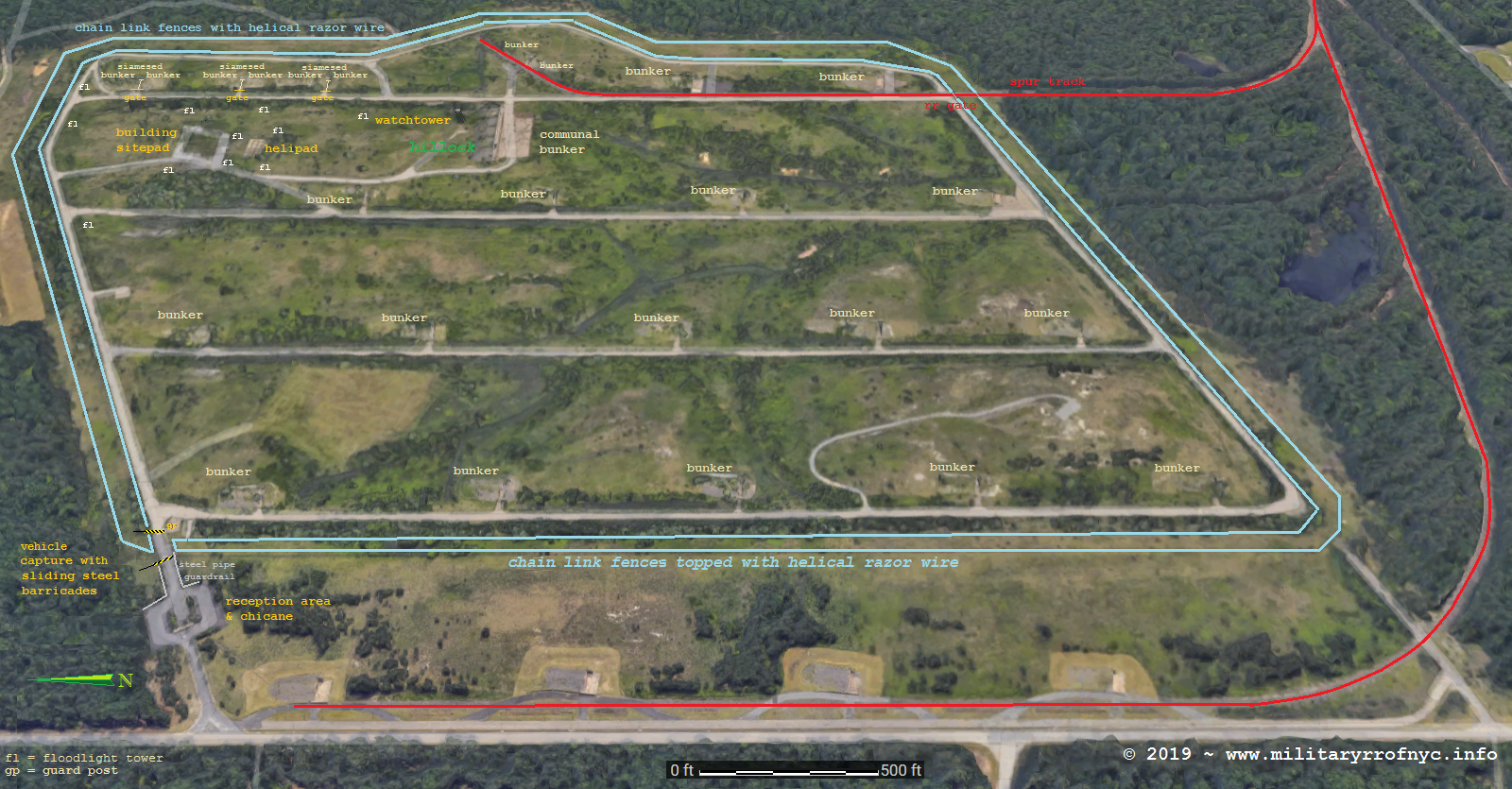
Google Maps Satellite Imagery - Special Weapons Compound (de-commissioned), Earle N. A. D. - Colts Neck, NJ
(north is left)
annotated image by author: © 2019 - www.freightrrofnyc.info
added 07 May 2019
.
.
. While researching this chapter, this author located the following question dated June 2, 2008; as posted on the Federation of American Scientists website:
| "Were Nuclear weapons stored at Naval Weapons Station Earle in NJ at one time? Are there any stored there currently?" "Yes, NWS Earle was one of two primary naval nuclear weapon storage sites on the Atlantic coast (the other being NWS Yorktown in Virginia). When the Navy retired the Terrier, ASROC and SUBROC weapons in the late 1980s and early 1990s, however, Earle lost its main role. And with the retirement of nuclear depth charges and denuclearization of the surface fleet in 1994, all remaining naval nuclear weapons (Tomahawk and Trident) for East Coast forces were consolidated at Strategic Weapons Facility Atlantic at Kings Bay in Georgia in 1997." |
Boxcar Revetments - Above Ground Magazines
Returning to conventional weapons, and when loaded with those munitions, the boxcars are stored in three sided revetments within the Earle Base. The design of these revetments as so, that in the even of a accidental detonation, the force of the blast will be focused up, instead of along the surface of the ground, and in doing so, protecting other neighboring revetments.
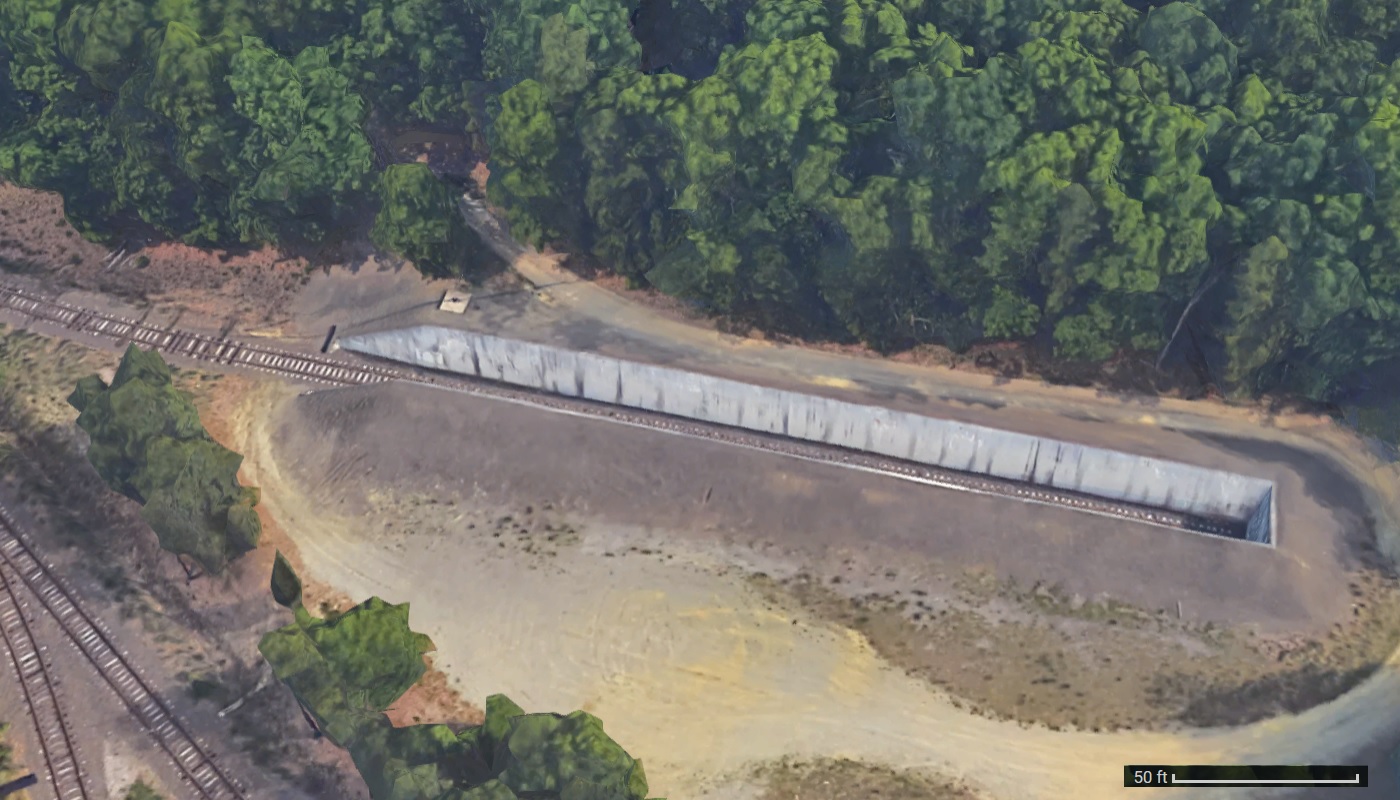
Above Ground Magazine - boxcar revetment (empty)
Naval Weapons Station Earle - Mainside; Colts Neck, NJ
Google Maps
annotated image: © 2019 by author
.
.
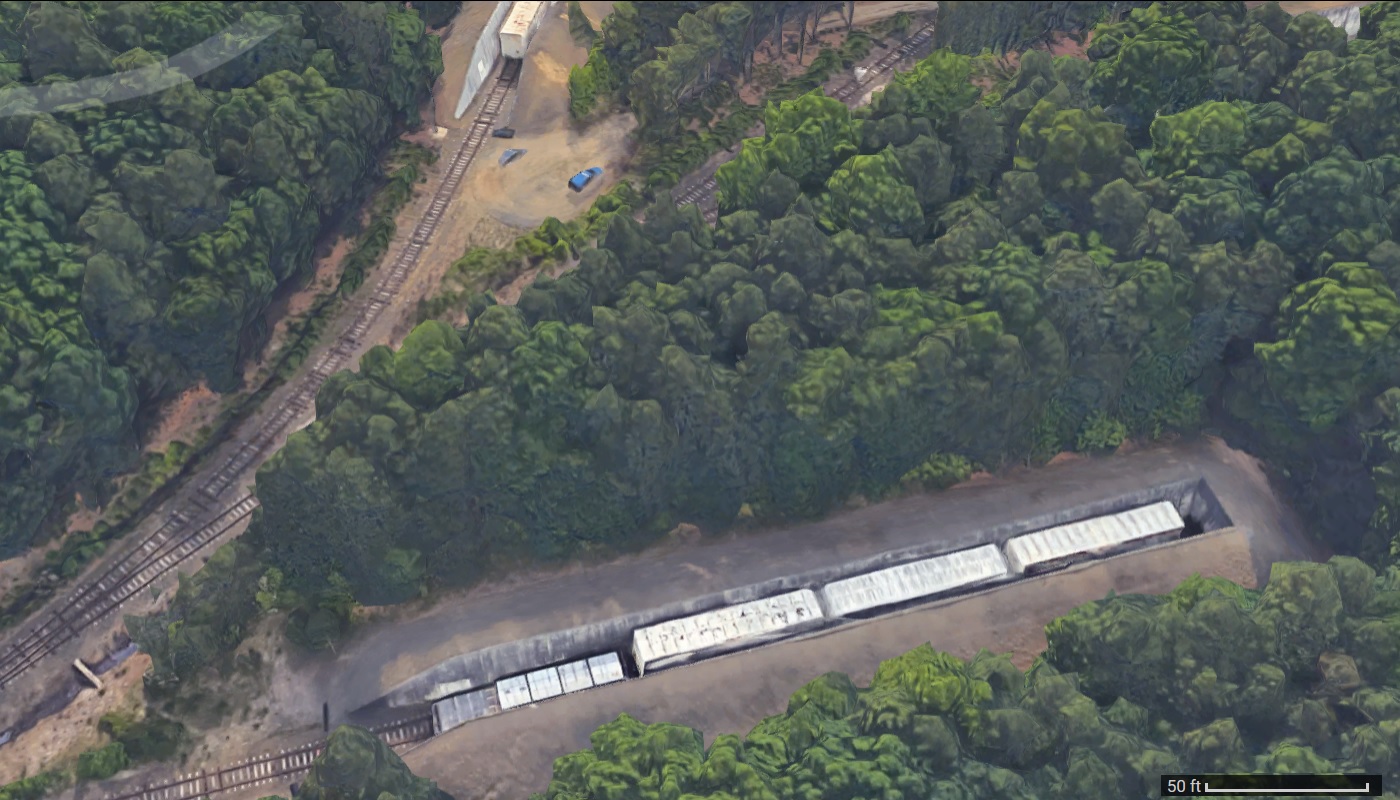
Above Ground Magazine - boxcar revetment (loaded)
Naval Weapons Station Earle - Mainside; Colts Neck, NJ
Flat car with palletized load to left, three box cars to right.
Google Maps aerial
annotated image: © 2019 by author
added 06 May 2019
.
.
Earth Covered Magazines - Munitions Bunkers with Stub Tracks
Another type of activity for the railroad is to spot a boxcar or two in front of the platform at the an enclosed bunkers or Earth Covered Magazines.
Sections of the Earle Ammunition Depot have earth covered munitions magazines, either individual or "communal" with steel doors securing the entrances. The magazines are above ground, constructed of reinforced concrete, with earth pushed up on three sides, and of which also thinly covers a roof. In the event of an explosion, the forces are directed to go through the thin roof instead of sideways and affecting other magazines. In the following image you can see a communal magazine flanked by two sets of three individual magazines. Note the rightmost magazine set has an additional security perimeter in the form of a chain link fence around it.
A short (200 foot or so) stub track turns out from the running track and dead ends in front of each magazine or a set of magazines. This way, the train crew can spot several different boxcars at different individual magazines for loading or unloading by ordnance personnel. Loop or balloon tracks surround each group of magazines so the locomotive may access the boxcars from either direction.
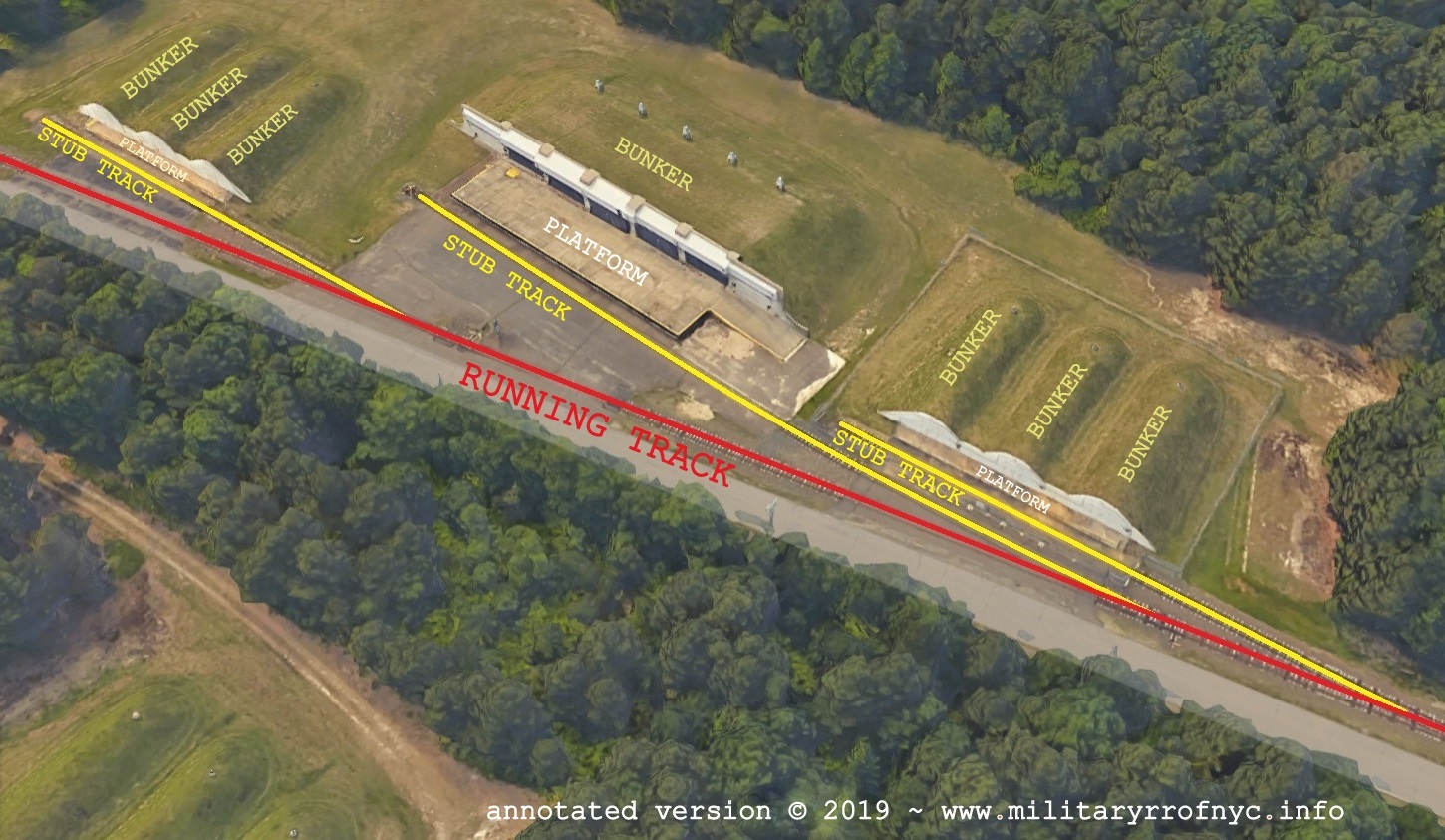
earth covered magazines & stub tracks
Naval Weapons Station Earle - Mainside; Colts Neck, NJ
Google Maps aerial
annotated image: © 2019 by author
added 06 May 2019
..
.
Storage Units with Stub Tracks
Yet another subsection of the Earle Base, has what appears to be modular or double wide prefabricated storage units with unloading platforms in front. These appear to be the lightest duty storage structures for munitions on the site. Perhaps small arms ammunition, flares and other incidental items?
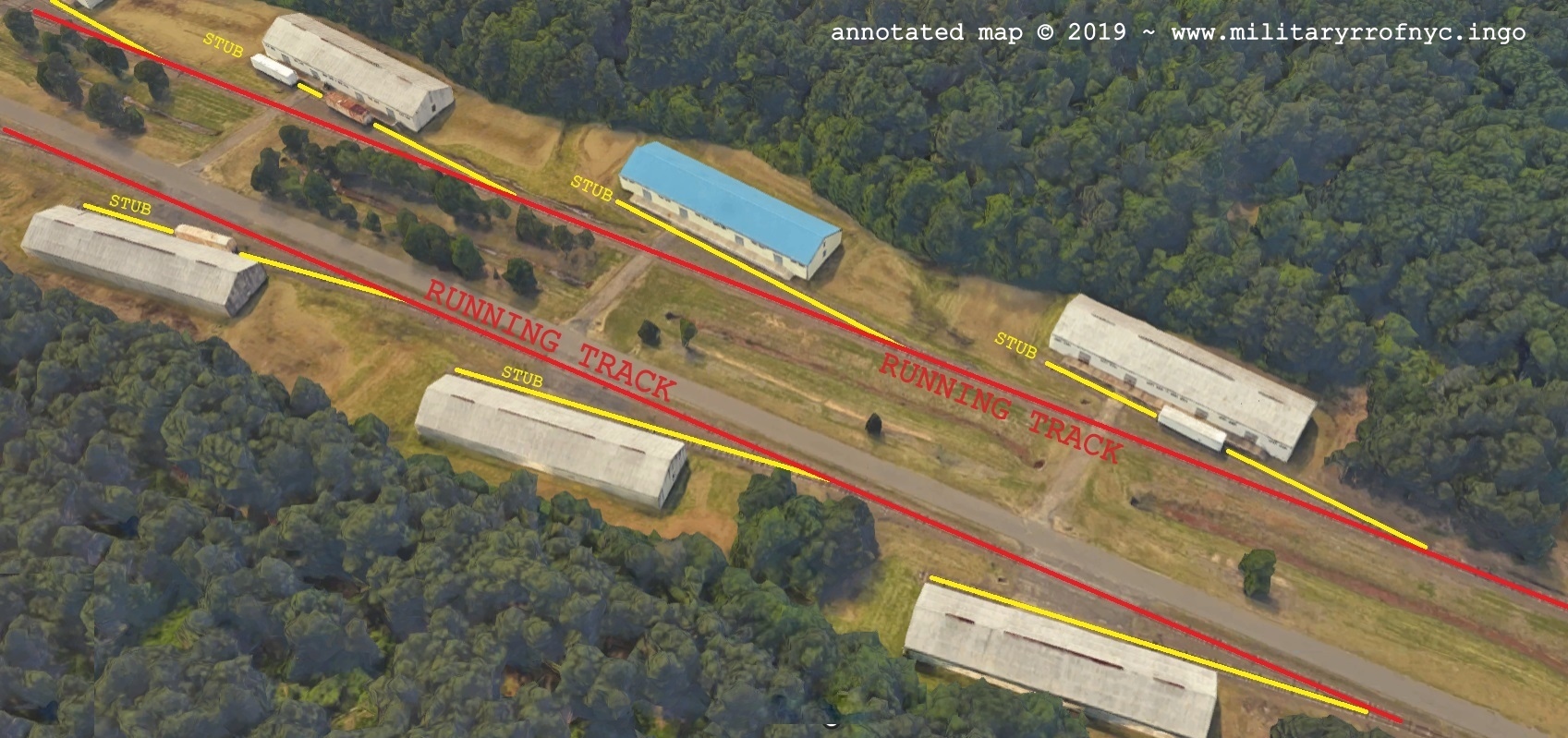
storage units & stub tracks
Naval Weapons Station Earle - Mainside; Colts Neck, NJ
Google Maps aerial
annotated image: © 2019 by author
added 06 May 2019
.
.
.| URHS # | car name | present location | car condition | history | original car configuration |
| 317 | "New York Central" | Tuckahoe, NJ | stored serviceable | ex-New Jersey Transit 5317, exx-110, exxx-Central RR of New Jersey, exxxx-Burlington Northern 4817, nee-Great Northern 1216 | 108-seat coach rebuilt from Pullman Standard lightweight 48-seat leg-rest coach |
| 326 | "Erie" | Batesville, MS | stored serviceable | ex-New Jersey Transit 5326, exx-129, exxx-Central RR of New Jersey, nee-Great Northern 1139 | 106-seat coach rebuilt from American Car Foundry lightweight 60-seat coach |
| 327 | "Lackawanna" | Batesville, MS | stored serviceable | ex-New Jersey Transit 5327, exx-119, exxx-Central RR of New Jersey, nee-Great Northern 1127 | |
| 329 | "Pennsylvania" | Tuckahoe, NJ | stored serviceable | ex-New Jersey Transit 5329, exx-100, exxx-Central RR of New Jersey, exxxx-Great Northern 1007, nee-Union Pacific 5487 | 108-seat coach rebuilt from Pullman Standard lightweight 48-seat leg-rest coach |
| 331 | "Reading" | Boonton, NJ | stored serviceable | ex-New Jersey Transit 5331, exx-115, exxx-Central RR of New Jersey, exxxx-Great Northern 1000, nee-Union Pacific 5469 | 108-seat coach rebuilt from American Car Foundry lightweight 44-seat leg-rest coach |
| 332 | "Lehigh Valley" | Boonton, NJ | caught fire, status? | ex-New Jersey Transit 5332, exx-121, exxx-Central RR of New Jersey, exxxx-Great Northern 1001, nee-Union Pacific 5470 | info needed |
| 333 | "Baltimore & Ohio" | Batesville, MS | stored serviceable | ex-New Jersey Transit 5333, exx-123, exxx-Central RR of New Jersey, exxxx-Great Northern 1002, nee-Union Pacific 5471 | 108-seat coach rebuilt from American Car Foundry lightweight 44-seat leg-rest coach |
| 334 | "Jersey Central" | Boonton, NJ | stored serviceable | ex-New Jersey Transit 5334, exx-112, exxx-Central RR of New Jersey, exxxx-Great Northern 1005, nee-Union Pacific 5477 | info needed |
As this event last took place in June 2000, the next one (which not scheduled or even announced) is estimated to be 2025, but scuttlebutt is it will not take place as a result of heightened security atmosphere due to actions of acrimony towards the United States.
Photographs and video of the 2000 excursion can be seen here:
| Volunteer Railroader Association - Earle Naval Weapons Station Railroad Excursion - June 25, 2000 |
| C. Esposito Video - Earle Naval Weapons Station Railroad Excursion - June 25, 2000 |
.
.
Coming out of the southern border of Mainland is a single track that extends another 20 miles or so south to Lakehurst Naval Air Engineering Station, Fort Dix and MacGuire Air Force Base. Yes, that Lakehurst, where the zeppelin Hindenburg caught fire and crashed in 1937. It is now the Naval Air Warfare Engineering Center Lakehurst, and is a test facility. Part of their experiments utilize weighted sleds powered by jet engines set on railroads tracks, but as this is not a true railroad, it is out of the purview of this website.
Well, maybe for another time...
.
.
ATTENTION READERS: This is an active duty military installation. It is NOT open to the public, and all roads leading to the facility are heavily patrolled. No photography is allowed without consent of Station Commander. Violators subject to fine and/or imprisonment. |
| Return to Index |
.
As the creation of Earle Naval Ammunition Depot took place during the middle of second generation of diesel designs in production, we are fortunate enough to witness a very nice assortment of motive power at this location through the years: operations started with total of ten Baldwin VO660 and VO1000. Four Whitcomb 80 tonners came to the facility shortly after. Eleven GE / ALCo RSX4 (MRS1) and three GE 80 tonners came in the 1950's, (one of which is still seen in recent aerial imagery) two EMD SW1200 and one SW900 to round off the lot. The Baldwins operated right through the 90's, and were the most famous (and photographed!) of the locomotive fleet to have operated at Earle.
Not all locomotives operated at this location at the same time, and would be reassigned to another base throughout the years.
The roster doesn't end there: the newest locomotives to arrive: a pair of National Railway Equipment 3GS21B "Gen Sets" (truck engines powering generator packs in an individually replaceable set). Each "Gen Set" is turned on (automatically) as more power is needed or turned off as it is not, as opposed to one big engine running all the time. This arrangement helps new switching locomotives meet current environmental standards:
| Weapons Station Earle Going Green with Delivery of New Locomotives |
.
The photo section below begins with oldest locomotive at top (the Baldwins) and progresses to the newest at the bottom (the NRE Gen Sets).
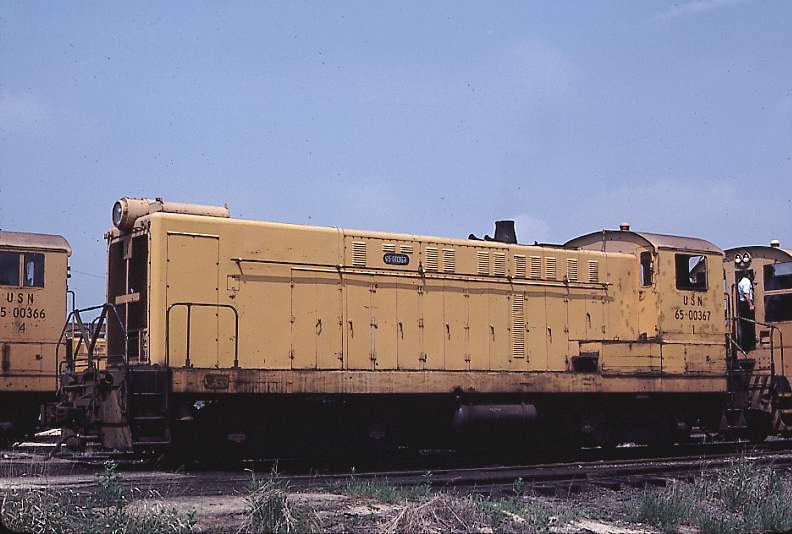 Earle #1 (65-00367) [Baldwin S12] before rebuilding - Earle, NJ - May 30, 1981 Olev Taremae photo courtesy of Baldwin Diesel Zone added 06 May 2019 |
| . . |
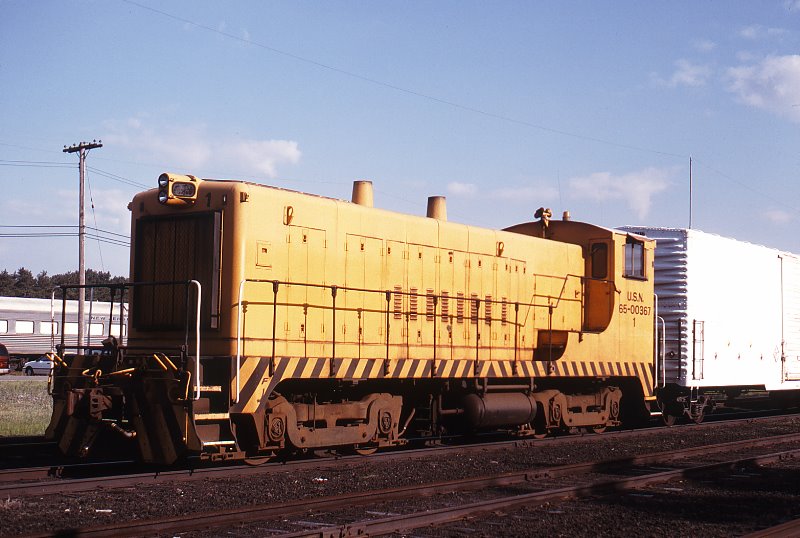 Earle NAD #1 (65-00367) after rebuilding - Colts Neck, NJ - June 24, 2000 Richard Adams photo courtesy of Baldwin Diesel Zone added 06 May 2019 |
| . . |
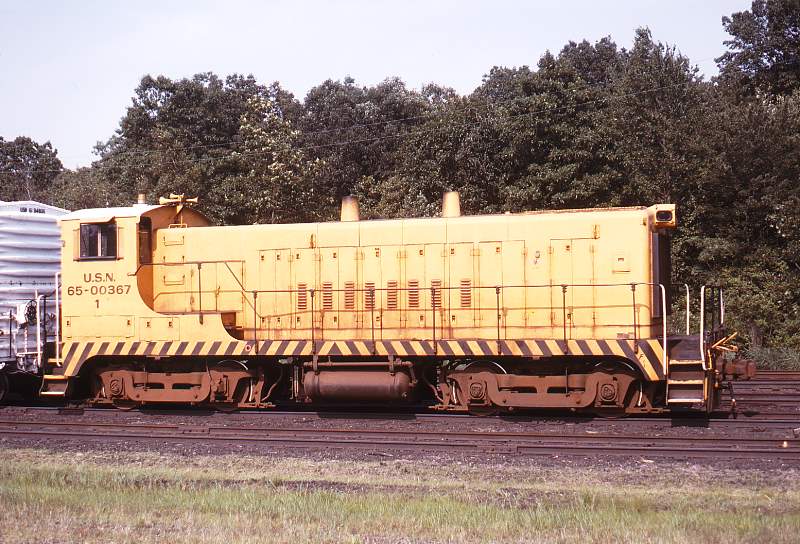 Earle NAD #1 (65-00367) after rebuilding - Colts Neck, NJ - June 24, 2000 Richard Adams photo courtesy of Baldwin Diesel Zone added 06 May 2019 |
| . . |
 Earle NAD #2 (65-00368) [Baldwin S12] - before rebuilding - Earle, NJ - May 30, 1981 Olev Taremae photo courtesy of Baldwin Diesel Zone added 06 May 2019 |
| . . |
 Earle NAD #2 (65-00368) after rebuilding - Colts Neck, NJ - June 24, 2000 Richard Adams photo courtesy of Baldwin Diesel Zone added 06 May 2019 |
| . . |
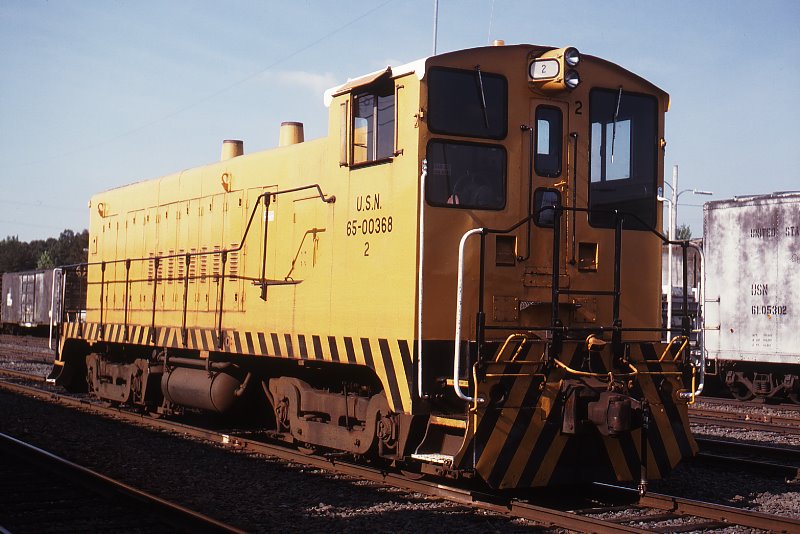 Earle NAD #2 (65-00368) after rebuilding - Colts Neck, NJ - June 24, 2000 Richard Adams photo courtesy of Baldwin Diesel Zone added 06 May 2019 |
| . . |
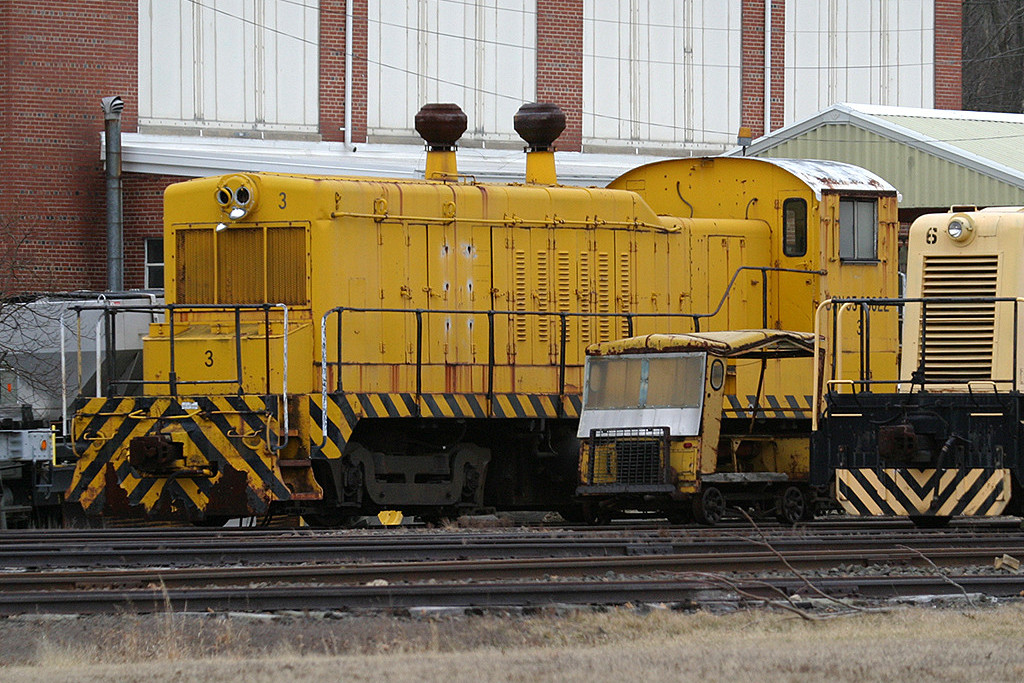 Earle NAD #3 (65-00622) - after rebuilding - Colts Neck, NJ - February 8, 2012 Senga Butts photo courtesy of Railroad Picture Archives added 06 May 2019 |
| . . |
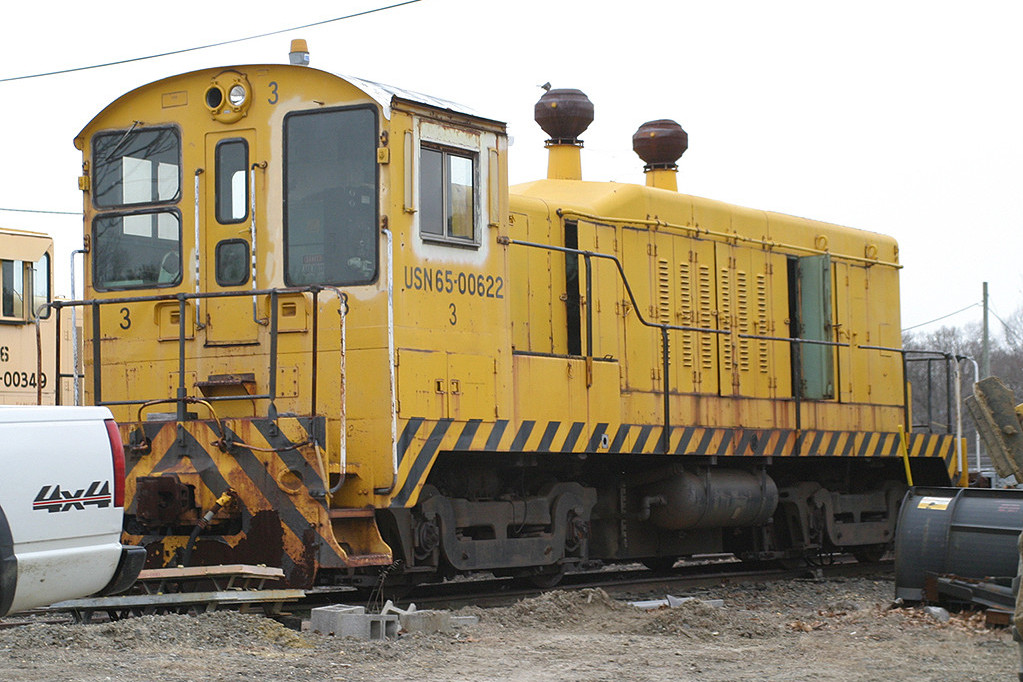 Earle NAD #3 (65-00622) - Colts Neck, NJ - February 8, 2012 - note the Senga Butts photo courtesy of Railroad Picture Archives added 06 May 2019 |
| . . |
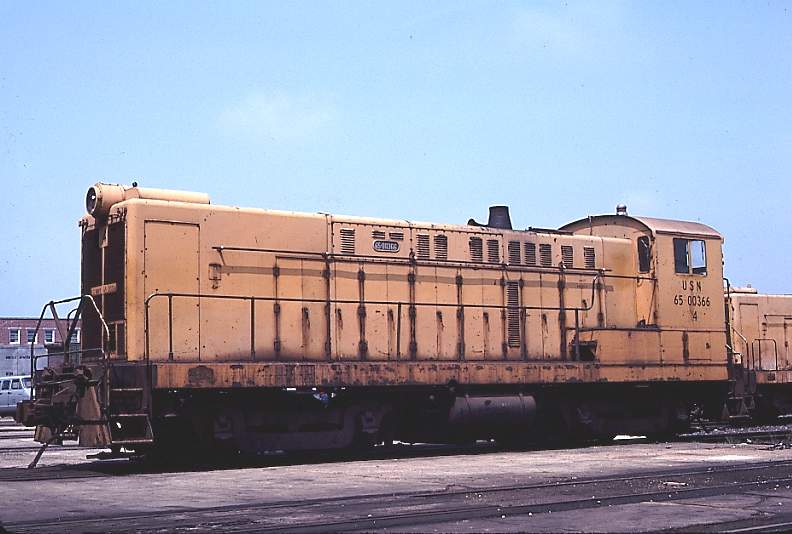 Earle NAD #4 (65-00366) [Baldwin S12] - Earle, NJ - May 30, 1981 Olev Taremae photo courtesy of Baldwin Diesel Zone added 06 May 2019 |
| . . |
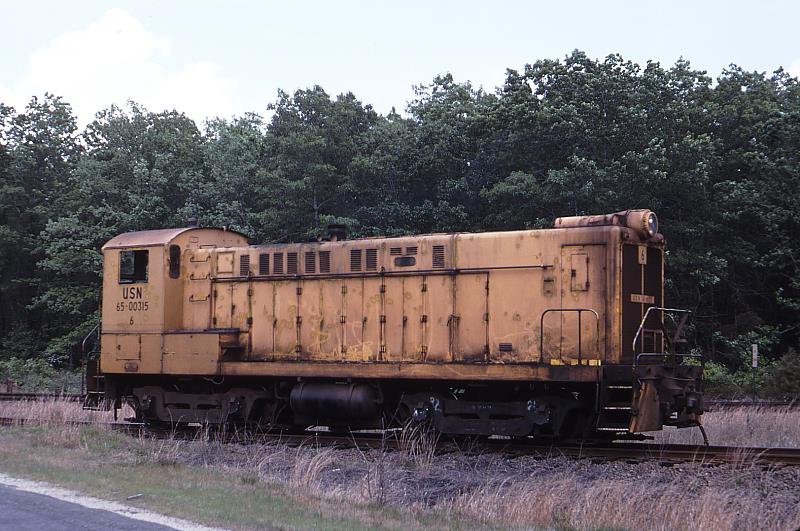 Earle NAD #6 (65-00315) [Baldwin S12] - Earle, NJ - May 30, 1981 Richard Adams photo courtesy of Baldwin Diesel Zone added 06 May 2019 |
| . . |
.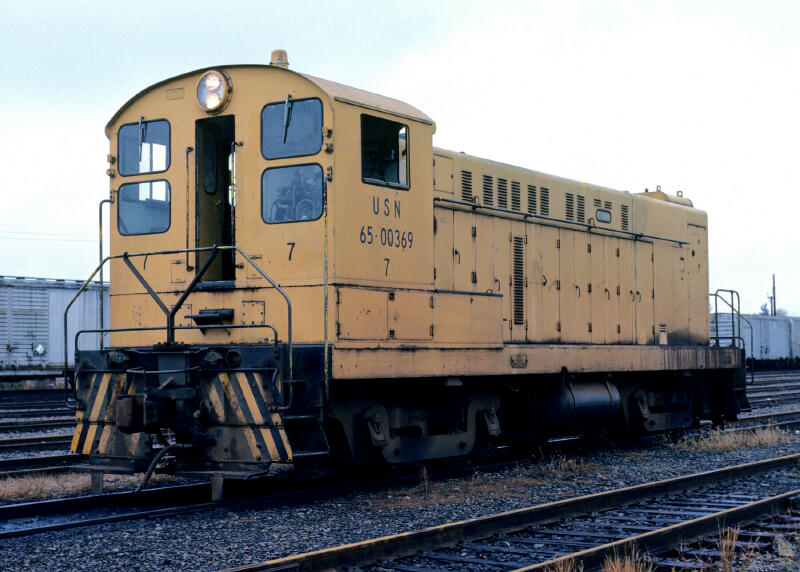 .Earle #7 (65-00369)
before rebuilding - November 4 1977 - Earle, NJ Tom Trencansky photo courtesy of Baldwin Diesel Zone added 06 May 2019 |
| . . |
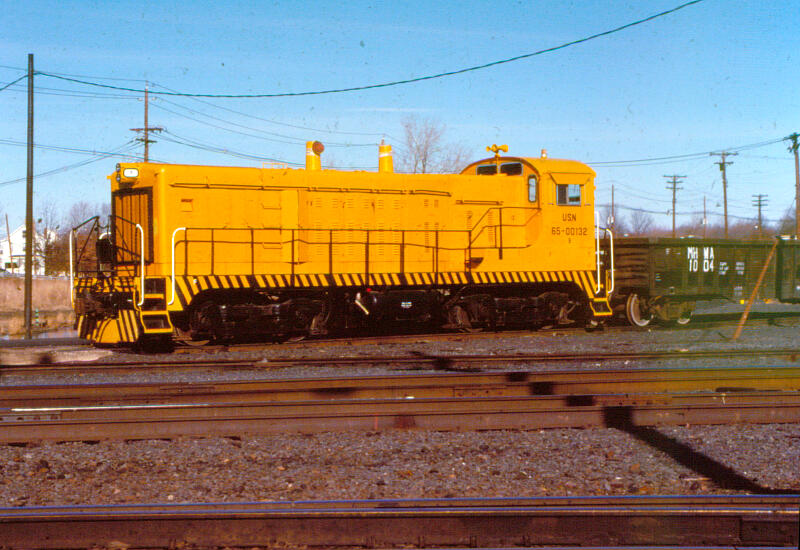 Earle #9 (65-00132) after rebuilding - January 1996 David Hutchinson photo courtesy of Baldwin Diesel Zone added 06 May 2019 |
| . . |
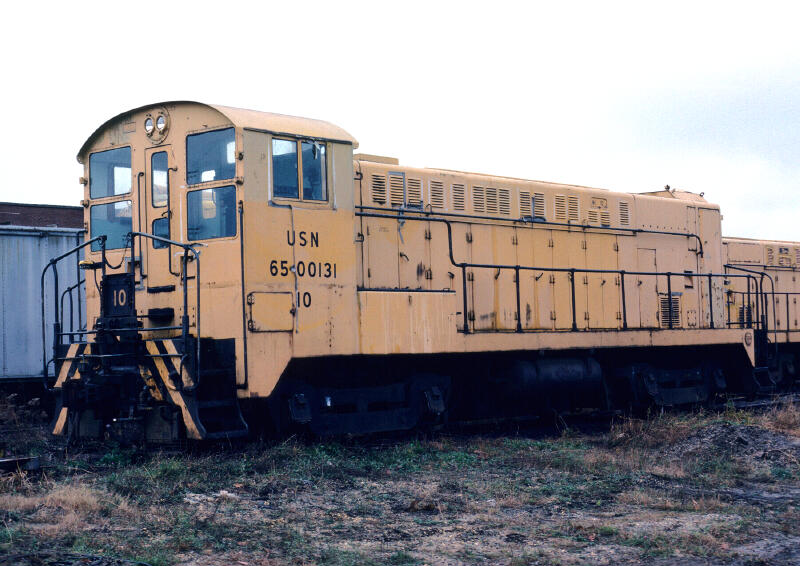 #10 (65-00131) - Earle, NJ - Nov. 4, 1977 added 06 May 2019 |
| . . |
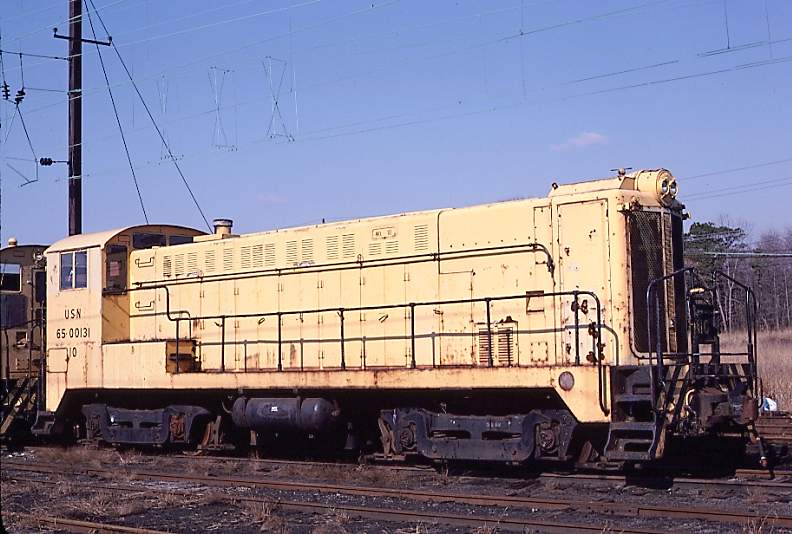 #10 (65-00131) [Baldwin VO-1000]- Earle, NJ - March 21, 1981 Richard Louderback photo collection of Mark Laundry added 06 May 2019 |
| . . |
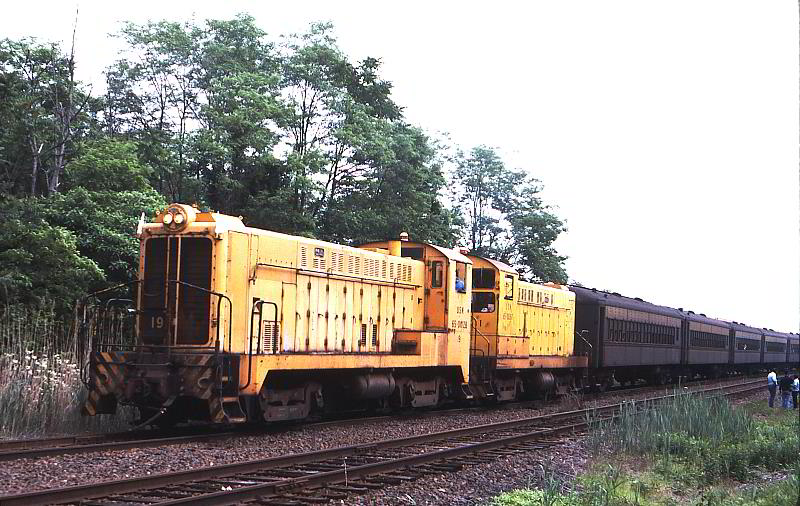 Earle #19 (USN 65-00128) [Baldwin VO-1000] with Earle #1 (65-00367) - Earle, NJ - May 30, 1981 Richard Adams photo added 06 May 2019 |
| . . |
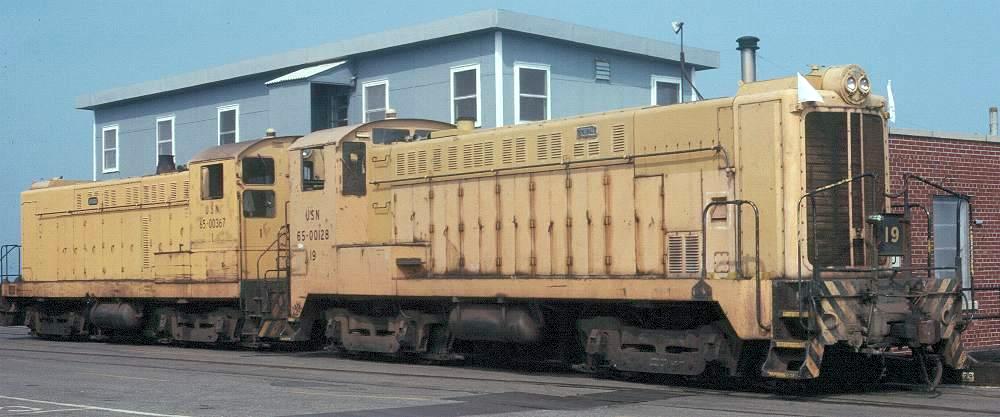 Earle #19 (USN 65-00128) [Baldwin VO-1000] with Earle #1 (65-00367) - Earle, NJ - May 30, 1981 Richard Adams photo added 06 May 2019 |
| . . |
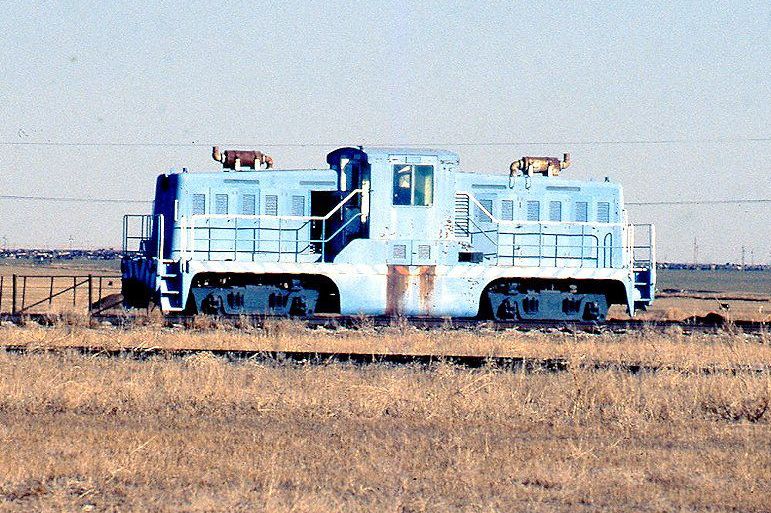 Earle #? (65-00434) [GE 80 ton] @ Cattle Town Feeds, Inc. - Summerfield, TX - February 2004 courtesy of Don Ross collection added 06 May 2019 |
| . . |
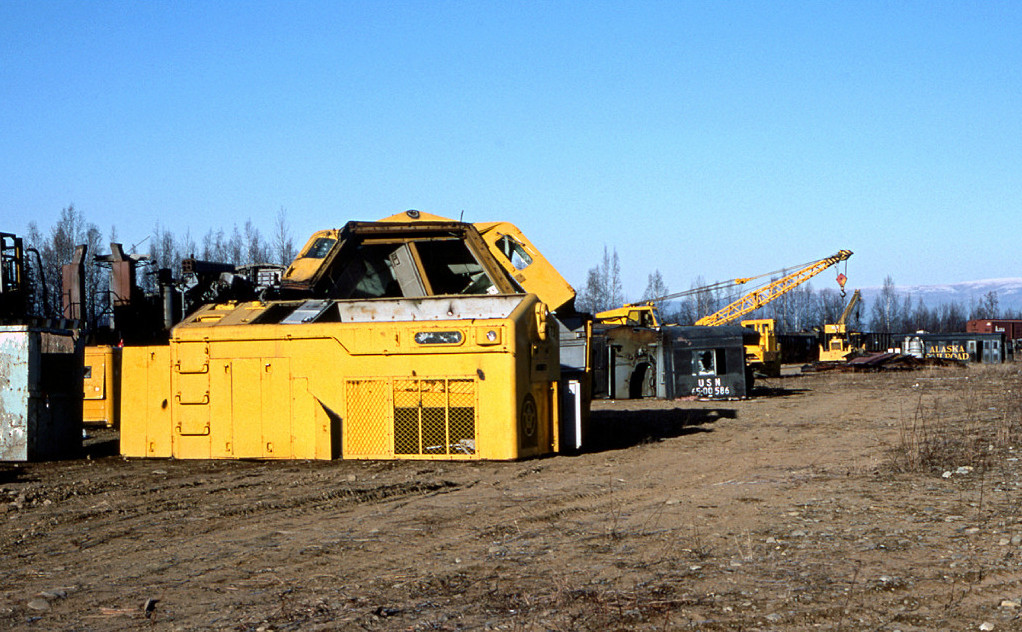 Earle NAD #5 (65-00586) [RSX4] being parted out at Alaska RR - Birchwood, AK - 10/20/1984 J. Fischer photo courtesy of Railroad Picture Archives added 06 May 2019 |
| . . |
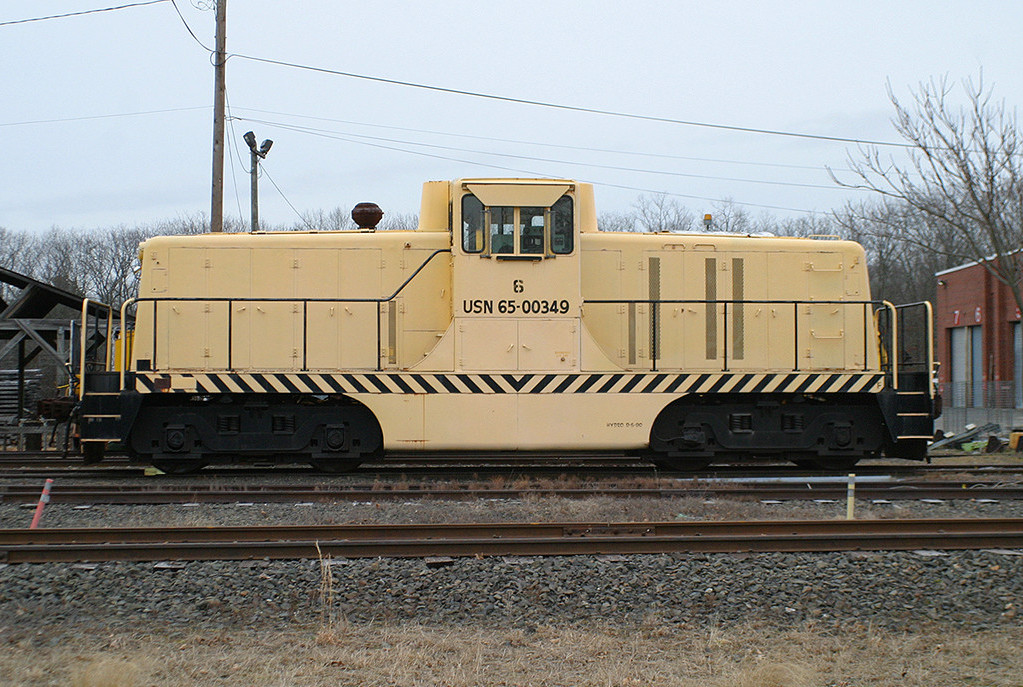 Earle NAD #6 (65-00349) [GE 80 ton] - Colts Neck, NJ - February 8, 2012 Senga Butts photo courtesy of Railroad Picture Archives added 06 May 2019 |
| . . |
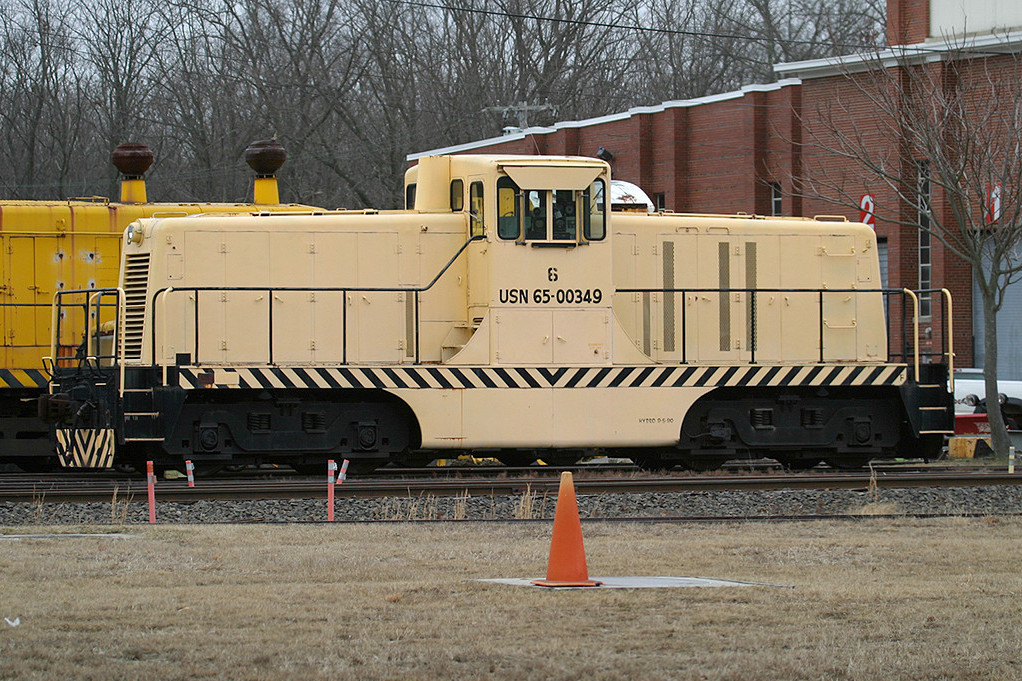 Earle NAD #6 second (65-00349) [GE 80 ton] - Colts Neck, NJ - February 8, 2012 Senga Butts photo courtesy of Railroad Picture Archives added 06 May 2019 |
| . . |
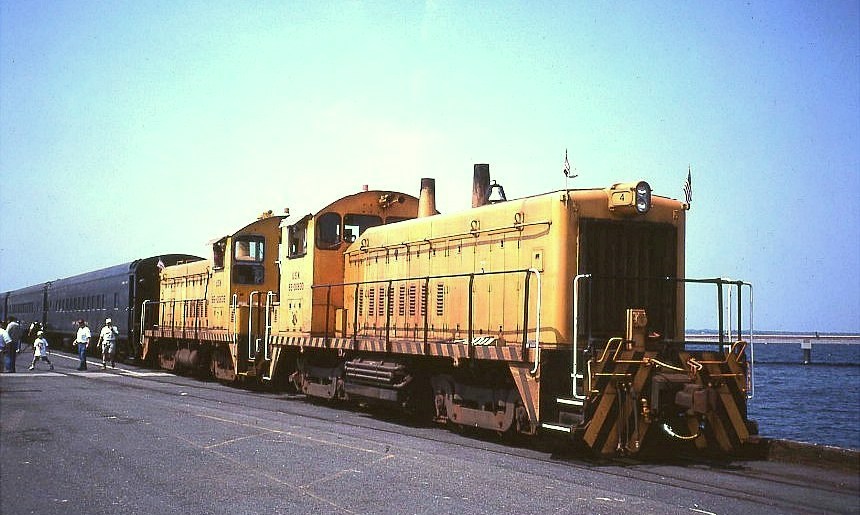 Earle #4 (65-00630) [EMD SW1200] & Earle NAD #7 (65-00636) [EMD SW990m]- Leonardo Pier Complex - 6/25/2000 Bob Vogel photo courtesy of Railroad Picture Archives added 06 May 2019 |
| . . |
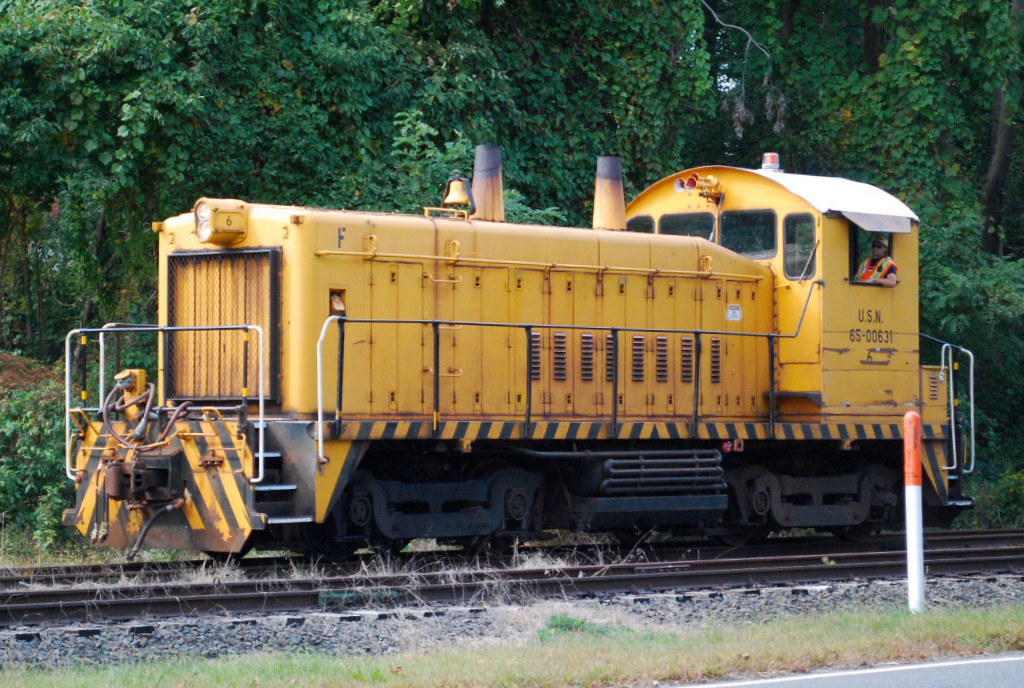 Earle NAD #6 third (65-00631) [EMD SW1200]- Middletown, NJ - 9/30/2013 Eric Kreszl photo courtesy of Railroad Picture Archives added 06 May 2019 |
| . . |
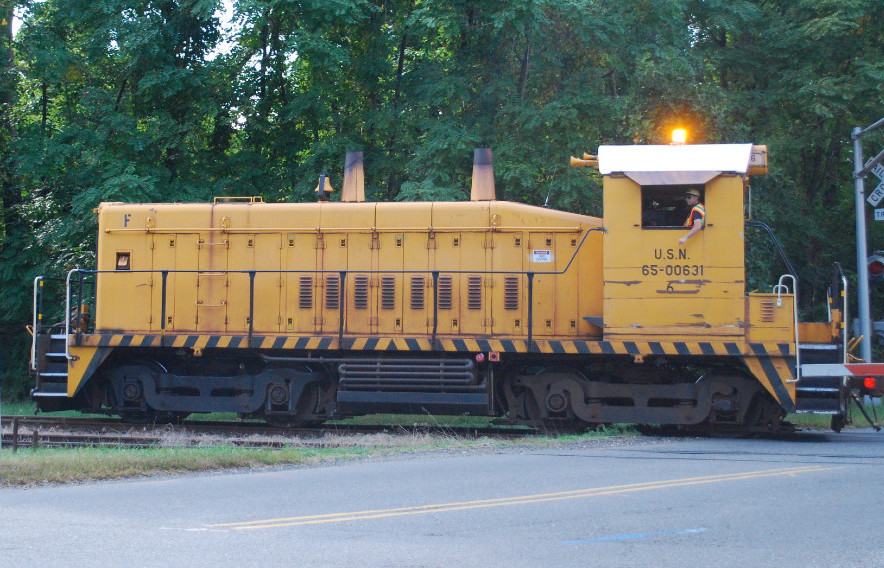 65-00631 third (65-00631) [EMD SW1200]- Middletown, NJ - 9/30/2013 Eric Kreszl photo courtesy of Railroad Picture Archives added 06 May 2019 |
| . . |
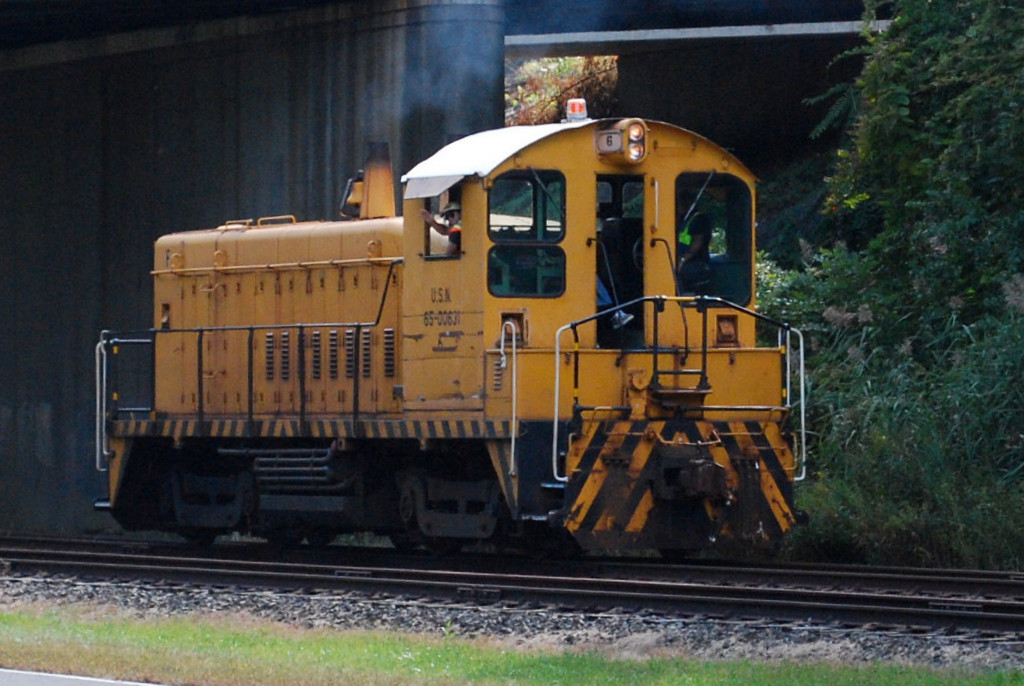 65-00631 third (65-00631) [EMD SW1200]- Middletown, NJ - 9/30/2013 Eric Kreszl photo courtesy of Railroad Picture Archives added 06 May 2019 |
| . . |
 Earle #7 (65-00???) US Navy photo added 05 May 2019 |
| . . |
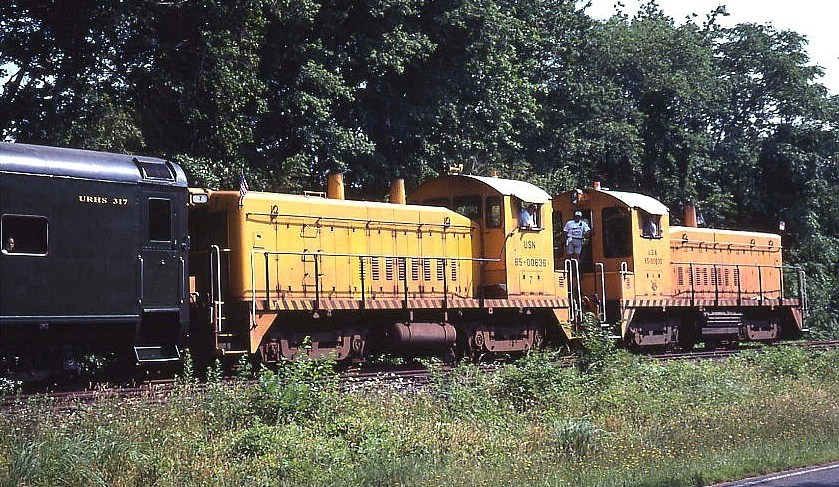 Earle NAD #7 (65-00636) [EMD SW900m] & Earle #4 (65-00630) [EMD SW1200] - Colts Neck, NJ - 6/25/2000 Bob Vogel photo courtesy of Railroad Picture Archives added 06 May 2019 |
| . . |
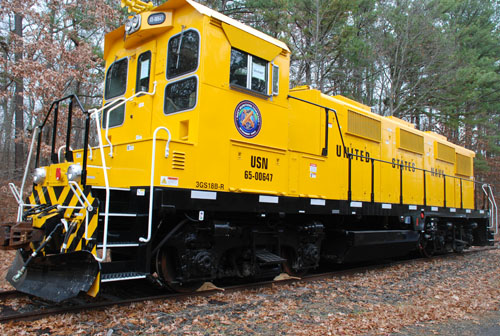 65-00647 [NRE 3GS21B-R] - December 2013 U.S. Navy / Mike Brady photo added 06 May 2019 |
| . . |
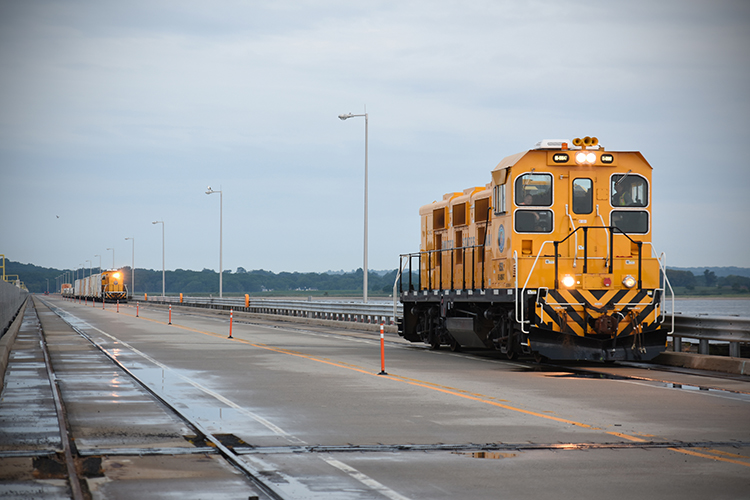 65-00647 [NRE 3GS21B-R] with 65-00648 [NRE 3GS21B-R] in distance - Leonardo Pier - unknown date U.S. Navy photo added 06 May 2019 |
| . . |
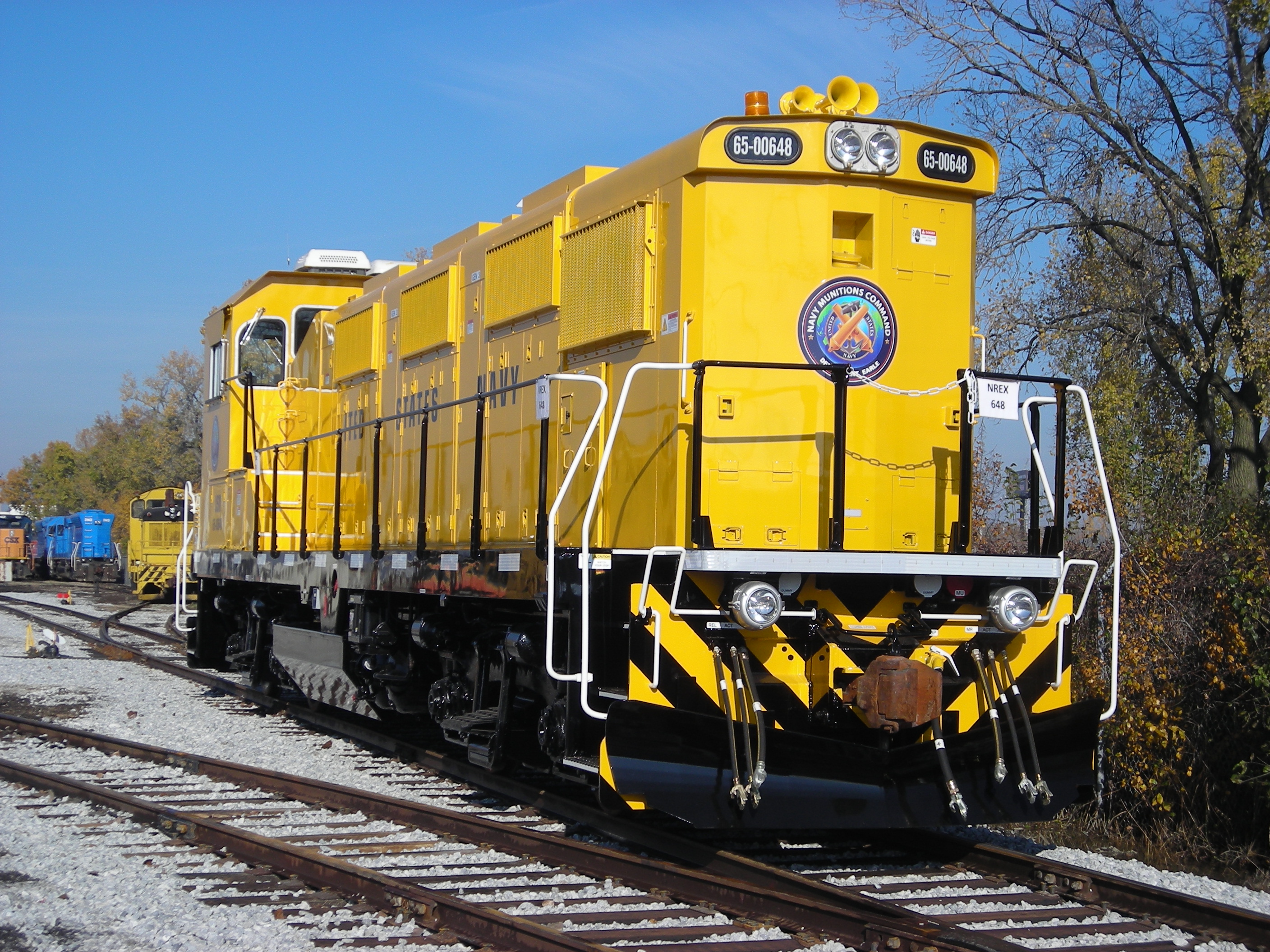 65-00647 [NRE 3GS21B-R] - unknown date NRE Website photo added 06 May 2019 |
US Navy Earle Naval Ammunition Depot / Naval Weapons Depot Locomotive Roster
All
locomotives known to have operated at Earle Naval Ammunition Depot /
Naval Weapons Station Earle were standard gauge and diesel electric.
(The
GE RSX4 / MRS1 were adjustable gauge: 56½" to 66" as per
military specifications, but only operated standard gauge at Earle NAD.)
builder |
c/n |
build date |
model | wheel arrangement |
number / name | US Navy number | acquired |
disposition |
notes |
ref |
| NRE | 5516-61 | 8/2013 | 3GS21B-R | B-B | 65-00647 | new | in service | NREX 647 (3GS21B) 123 tons 2100 horsepower |
||
| NRE | 8/2013 | 3GS21B-R | B-B | 65-00648 | new | in service | NREX 648 (3GS21B) | |||
| EMD | 20064 | 11/1954 | SW1200 | B-B | Earle NAD #4 | 65-00630 | used | acquired 1987 ex-Chicago Milwaukee St Paul & Pacific #634 exx-Chicago Milwaukee St Paul & Pacific #2029 (first) | ||
| EMD | 20075 | 11/1954 | SW1200 | B-B | Earle NAD #6 | 65-00631 | used |
September 1987: sold to USN
65-00631 | ||
| EMD | 26020 | 4/1960 | SW900m | B-B | Earle NAD #7 | 65-00636 | used | rebuilt to 1200 hp ex-Chicago Northwestern #145 exx-Chicago, St. Paul, Minneapolis and Omaha #59 (second) | ||
| GE | (9/1943- 9/1946) | 45 ton | B-B | Earle NAD #3 | unknown 45 ton - not attributed in builders records, but seen marked as such at Iona Island, NY - research pending | red & yellow 45 ton centercab (Reed IIA-5 - 9/1943-9/1946) | ||||
| GE | 31180 | 2/13/1952 | 80 ton | B-B | 65-00310 | used | from US Army, New Cumberland Transp Corps Depot, Marietta, PA to Naval Weapons Center, Goose Creek, SC Denton Farm Park's Handy Dandy Railroad | 80 ton Cummins NHBIS-600 (2) 470hp B-B-160/160-4GE747 | ||
| GE / ALCo | 31653 | 6/16/1953 | RSX4 (MRS1) | C-C | Earle NAD # ? | 65-00584 | used | from US Army #2098, New Cumberland Transp Corps Depot, Marietta, PA | 120 ton Alco 12-244D 1600hp C-C-240/240-4GE731 (A-80331) | |
| GE / ALCo | 31654 | 6/16/1953 | RSX4 (MRS1) | C-C | Earle NAD #6 | 65-00585 | used | from US Army #2099, New Cumberland Transp Corps Depot, Marietta, PA to Eveready Supply (dealer), Bridgeport, CT Uruguay State Railway (AFE) #1612 | 120 ton Alco 12-244D 1600hp C-C-240/240-4GE731 (A-80332) | |
| GE / ALCo | 31655 | 4/15/1953 | RSX4 (MRS1) | C-C | Earle NAD #5 | 65-00586 | used | from US Army #2100, New Cumberland Transp Corps Depot, Marietta, PA | 120ton Alco 12-244D 1600hp C-C-240/240-4GE731 (A-80333) | |
| GE / ALCo | 31656 | 4/17/1953 | RSX4 (MRS1) | C-C | Earle NAD #14 | 65-00560 | used | from US Army #2101, New Cumberland Transp Corps Depot, Marietta, PA to Texas State RR Museum #8, Rusk, TX | 120 ton Alco 12-244D 1600hp C-C-240/240-4GE731 (A-80334) | |
| GE / ALCo | 31660 | 4/29/1953 | RSX4 (MRS1) | C-C | 65-00587 | used | from US Army #2105, New Cumberland Transp Corps Depot, Marietta, PA to South Branch Valley #26, Mooresfield, WV Cass Scenic #26, Cass, WV Uruguay State Railway (AFE) #1611 | 120 ton Alco 12-244D 1600hp C-C-240/240-4GE731 (A-80338) | ||
| GE / ALCo | 31662 | 5/6/1953 | RSX4 (MRS1) | C-C | Earle NAD #13 | 65-00588 | used | from US Army #2107, New Cumberland Transp Corps Depot, Marietta, PA to South Branch Valley #17, Mooresfield, W Va Cass Scenic #8, Cass, W Va | 120 ton Alco 12-244D 1600hp C-C-240/240-4GE731 (A-80340) | |
| GE / ALCo | 31664 | 5/12/1953 | RSX4 (MRS1) | C-C | Earle NAD #8 (third?) | 65-00589 | used | from US Army #2109, New Cumberland Transp Corps Depot, Marietta, PA to Uruguay State Ry (AFE) #1613 | 120 ton Alco 12-244D 1600hp C-C-240/240-4GE731 (A-80342) | |
| GE / ALCo | 31665 | 5/13/1953 | RSX4 (MRS1) | C-C | Earle NAD #9 | 65-00590 | used | from US Army #2110, New Cumberland Transp Corps Depot, Marietta, PA to US Department of Energy; Sandia Laboratory; Albuquerque, NM wrecked in collision tests, scrapped | 120 ton Alco 12-244D 1600hp C-C-240/240-4GE731 (A-80343) | |
| GE / ALCo | 31666 | 5/15/1953 | RSX4 (MRS1) | C-C | Earle NAD #12 | 65-00563 | used | from US Army #2111, New Cumberland Transp Corps Depot, Marietta, PA to Aaron Ferrer, Omaha, NE | 120 ton Alco 12-244D 1600hp C-C-240/240-4GE731 (A-80344) | |
| GE / ALCo | 31667 | 5/18/1953 | RSX4 (MRS1) | C-C | Earle NAD #10 (second) | 65-00591 | used | from US Army #2112, New Cumberland Transp Corps Depot, Marietta, PA to Morristown & Erie #2112, Morristown, NJ Eveready Supply (dealer), Bridgeport, CT Winchester & Western #2112, Winchester, VA (refused-Not delivered) Robert Brothers Coal #1, Mortons Gap, KY | 120 ton Alco 12-244D 1600hp C-C-240/240-4GE731 (A-80345) | |
| GE / ALCo | 31670 | 5/22/1953 | RSX4 (MRS1) | C-C | 65-00593 | used | from US Army #2115, New Cumberland Transp Corps Depot, Marietta, PA to US Dept of Energy, Sandia Labs, Albuquerque, NM | 120 ton Alco 12-244D 1600hp C-C-240/240-4GE731 (A-80348) | ||
| GE | 31824 | 3/20/1953 | 80 tonner | B-B | 65-00347 (third) | new | from
US Army, New Cumberland Transp Corps Depot, Marietta, PA for:
US Navy #65-00347, Naval Construction Battalion #10, Port
Hueneme, CA to US Navy #65-00347, Seal Beach Ammunition Depot #1, Seal Beach, CA Rebuilt – Johnson Railway Services - 8/1987 US Navy #65-00347, Naval Weapons Station, Goose Creek, SC | Cummins LI-600 (x2) 500hp B-B-160/160-4HM833 | ||
| GE | 31849 | 4/24/1953 | 80 tonner | B-B | 65-00383 | new | from US Army, New Cumberland Transp Corps Depot, Marietta, PA for US Navy Naval Ammunition Depot, Earle, NJ | Cummins LI-600 (x2) 500hp B-B-160/160-4HM833 | ||
| Baldwin | 75706 | 12/1952 | S12 | B-B | 65-00366 | new | Central Procurement Agency, for: US Navy | repowered | ||
| Whitcomb | 60511 | 6/1944 | 80DE7B | B-B | 65-00264 | new | to Beaufort & Morehead RR #85; Beaufort, NC (on property 9/16/1980) to Chesapeake RR #85; Clayton, DE (through 1999) present whereabouts unknown | Buda 6-DCS-169 (x2) (supercharged), 325 hp each at 1200 rpm | ||
| Whitcomb | 60512 | 6/1944 | 80DE7B | B-B | 65-00265 | new | Buda 6-DCS-169 (x2) (supercharged), 325 hp each at 1200 rpm | |||
| Whitcomb | 60513 | 6/1944 | 80DE7B | B-B | 65-00266 | new | Buda 6-DCS-169 (x2) (supercharged), 325 hp each at 1200 rpm | |||
| Whitcomb | 60514 | 6/1944 | 80DE7B | B-B | 65-00434 | new | to Pantex; Amarillo, TX? to Peavey Grain, to Cattle Town Feeders, Inc (no #); Summerville, TX (present 7/14/2018) | Buda 6-DCS-169 (x2) (supercharged), 325 hp each at 1200 rpm | ||
| Baldwin | 70324 | 12/30/1944 | VO 660 | B-B | Earle NAD #15 | 65-00454 | new | 660hp | ||
| Baldwin | 70325 | 12/29/1944 | VO 660 | B-B | Earle NAD #16 | 65-00127 | new | 660hp | ||
| Baldwin | 70326 | 12/28/1944 | VO 660 | B-B | Earle NAD #17 > 18 | 65-00130 | new | 660hp | ||
| Baldwin | 71430 | 2/7/1945 | VO 1000 | B-B | Earle NAD #19 | 65-00128 | new | to the URHS of NJ; painted as the fictitious B&O 412, leased to SMS as display locomotive | 1000hp | |
| Baldwin | 71940 | 8/07/1944 | VO 1000 | B-B | Earle NAD #8 (first) | 65-00125 | new | 1000hp | ||
| Baldwin | 71968 | 10/07/1944 | VO 1000 | B-B | Earle NAD #8 (second) > #10 | 65-00131 | new rb | EMD repowered to LTEX | 1000hp | |
| Baldwin | 71969 | 10/07/1944 | VO 1000 | B-B | Earle NAD #9 | 65-00132 | new rb | rebuilt by NRE Waycross; EMD repowered to NWS Charleston, reported 2012 | 1000hp | |
| Baldwin | 71970 | 10/27/1944 | VO 1000 | B-B | Earle NAD #10 (second) | 65-00133 | new | 1000hp | ||
| Baldwin | 70102 | 4/25/1943 | VO 1000 | B-B | Earle NAD #4 | new | 1000hp | |||
| Baldwin | 69659* | 10/04/1943 | VO 1000 | B-B | Earle NAD #3 | 65-00027 65-00622 | new rb | rebuilt October 1985 to VO-1000m (repowered with EMD) became 65-00622 | 1000hp *(c/n erroneously reported in contemporary accountings as 69559) | |
| Baldwin | 64260 | 11/1941 | S12 | B-B | 65-00347 (second) | used | nee- St Louis San Francisco 202 | |||
| Baldwin | 64259 | 11/1941 | S12 | B-B | 65-00368 (second) | used | nee- St Louis San Francisco 201 |
There are three locomotives that carried Earle NAD #8: Baldwin c/n 71968, Baldwin c/n 71940 and GE/Alco c/n 31664.
Also, there seems to be some differing methods regarding the numbering of the units. Images of the Baldwin units as seen on the website "The Baldwin Diesel Zone"; some are marked "first" and "second". This is possible, but this author in comparing images of those locomotives, noticed that the locomotives marked "second" appear to have been rebuilt and repowered with EMD equipment and cosmetics, i.e: single exhaust stack to dual stacks, EMD dual sealed beam headlights, and EMD style radiator shutters and housings on the nose. This author has always reserved the use of the "second" tag to denote a completely different locomotive carrying the same road number as a predecessor locomotive.
Further information is required, and images not included here are most certainly welcome. Please contact me at bedt14@aol.com
| Return to Index |
.
.
Flatcars
Boxcars - for Mobile & Temporary Storage
Another interesting aspect of the operation at Earle, are the Navy boxcars. They provide an efficient means of directly transloading munitions to and from the ships by bringing the boxcars directly shipside on the Leonardo Pier and loading or unloading directly. This eliminates one step of handling as would be the case if the ammunition were to be handled again at a permanent bunker site. And any reduction in the handling of munitions decreases the chances of an accident. This method is also beneficial when the munitions only need to be stored for a short period of time.
Fortunately, Sam Berliner III has already done some research on these cars.
These cars were built to haul ammunition and were purchased new in the 1950's. They were part of a group of 100 units, of which that had been recently reconditioned and repainted by a private contractor located in Star, NC. Most of the cars had a light weight of 68,000 pounds with a 105,000 pound load limit. Dimension are 19½' feet wide, 14' wide in side length of 50½'.
Cars 61-05178 and 61-06516 have a 177,000 pound load limit.
The car numbers are as follows: 61-06516, 65-04790, 61-04793, 61-05169, 61-61-05178, 61-04789, 61-04933, 61-05174, 61-05240, 61-06909, 61-06906, 61-06520, 61-05191, 61-04871, 61-06516 and 61-05171.
The cars are painted all white with red and yellow reflectors affixed to the sides in a staggered pattern.
There are two manufacturers of cars represented: most of the cars with riveted side panels were built by the Pressed Steel Corporation of New Jersey. This company was better known for their manufacture of the early Fox style of freight car trucks.
Cars 61-04726, 61-05240, 61-06520 have welded side panels and are similar to Pullman Standard PS-1 boxcars. Pullman Standard built two lots for the US Navy; USNX 8000 through 8879 in 1952 (DF loaders) later renumbered 28,000-28879. Then renumbered once again in the 61-xxxx series.
The second lot comprises of
61-04221 through 61-04260 built in 1954. All cars have CRECO doors,
either five or seven panels with the exception of 61-04790, 61-4793,
61-05171, 61-05174, and 61-05191 which have Youngstown corrugated
doors.
This material originally was compiled by the Railroad Prototype Modelers and the Philadelphia Chapter of the NRHS.
An interesting publication issued by the US Navy explains the refit of the boxcars:
| INDUSTRIAL HYGIENE TEAMS WITH PWC TO EXPEDITE RAILCAR RESTORATION AT NWS EARLE |
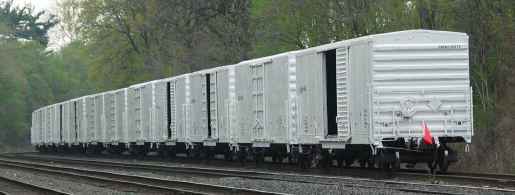 courtesy of Sam Berliner, III Sam Berliner, III's Naval Weapons Station Earle added 06 May 2019 |
| . . |
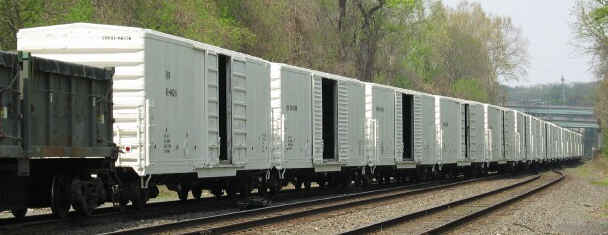 courtesy of Sam Berliner, III Sam Berliner, III's Naval Weapons Station Earle added 06 May 2019 |
| . . |
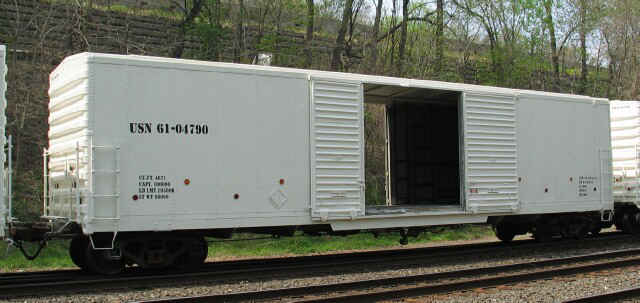 courtesy of Sam Berliner, III Sam Berliner, III's Naval Weapons Station Earle added 06 May 2019 |
| . . |
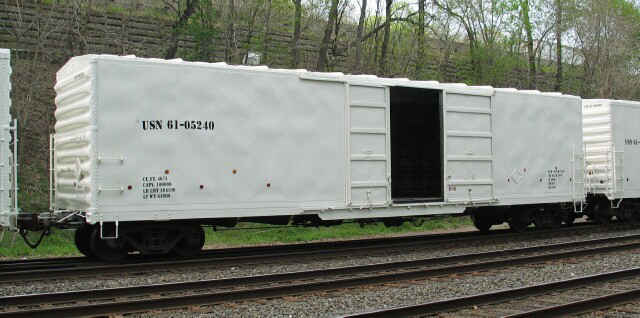 courtesy of Sam Berliner, III Sam Berliner, III's Naval Weapons Station Earle added 06 May 2019 |
| . . |
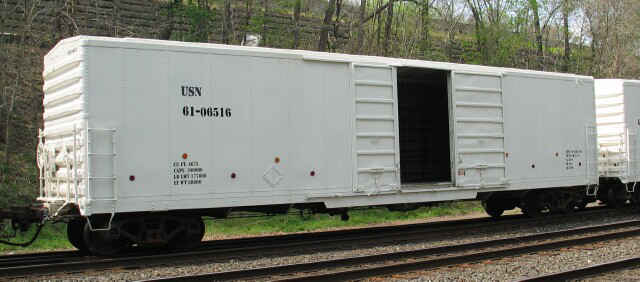 courtesy of Sam Berliner, III Sam Berliner, III's Naval Weapons Station Earle added 06 May 2019 |
| Return to Index |
.
ATTENTION READERS: This is an active duty military installation. It is NOT open to the public, and all roads leading to the facility are heavily patrolled. No photography is allowed without consent of Station Commander. Violators subject to fine and/or imprisonment. |
.
First and foremost,
I am very greatly indebted to Sam Berliner, III for allowing me to piggyback and use his information and images from his Naval Weapons Station Earle page. It was not my intent to create another page of Earle, but despite our similar interests, there were enough differences is subject matter that inspired me to author my own. I highly recommend you visit and read his website on Earle as well, as not all topics were covered on both pages.
Secondly, I would like to thank Baldwin Diesel Zone and Railroad Picture Archives and the respective photographers for use of their locomotive images.
And, sincere thanks to Richie King for providing the roster of passenger equipment used in the URHS 2000 excursion.
.
| Return to Index |
.
Index:
Military
Railroads of the New York Metropolitan AreA | ||||
| EARLE N.A.D. N.W.S. EARLE | ||||
| FORT TOTTEN | Fort Terry | Fort Hancock / SANDY HOOK PROVING GROUNDS | ||
| . SIGN THE GUESTBOOK | ||||
.